Meet our Head Gardener
We caught up with our Head Gardener, Claire Farrington to find out what inspires her and what made her come to Langdale Chase.
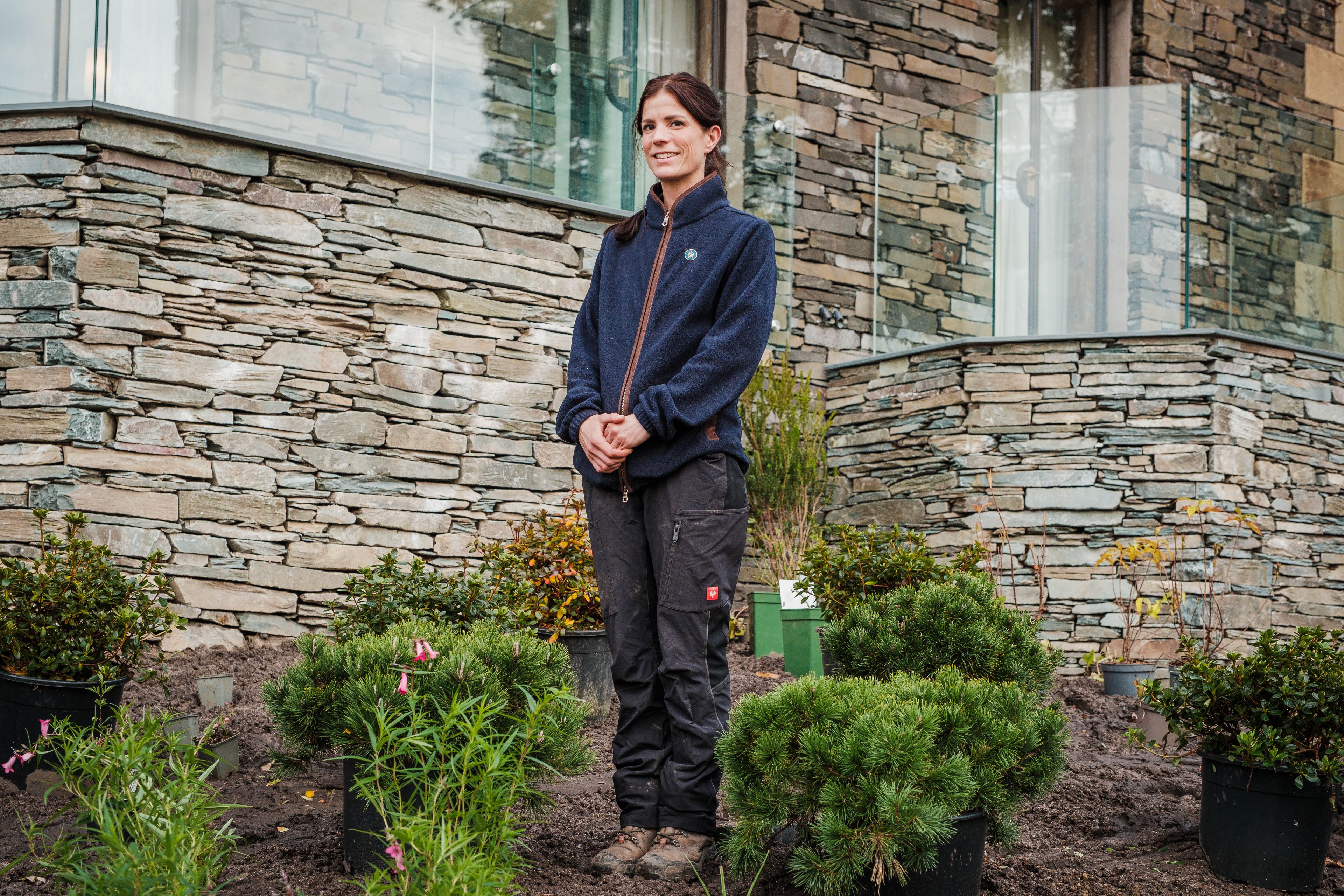
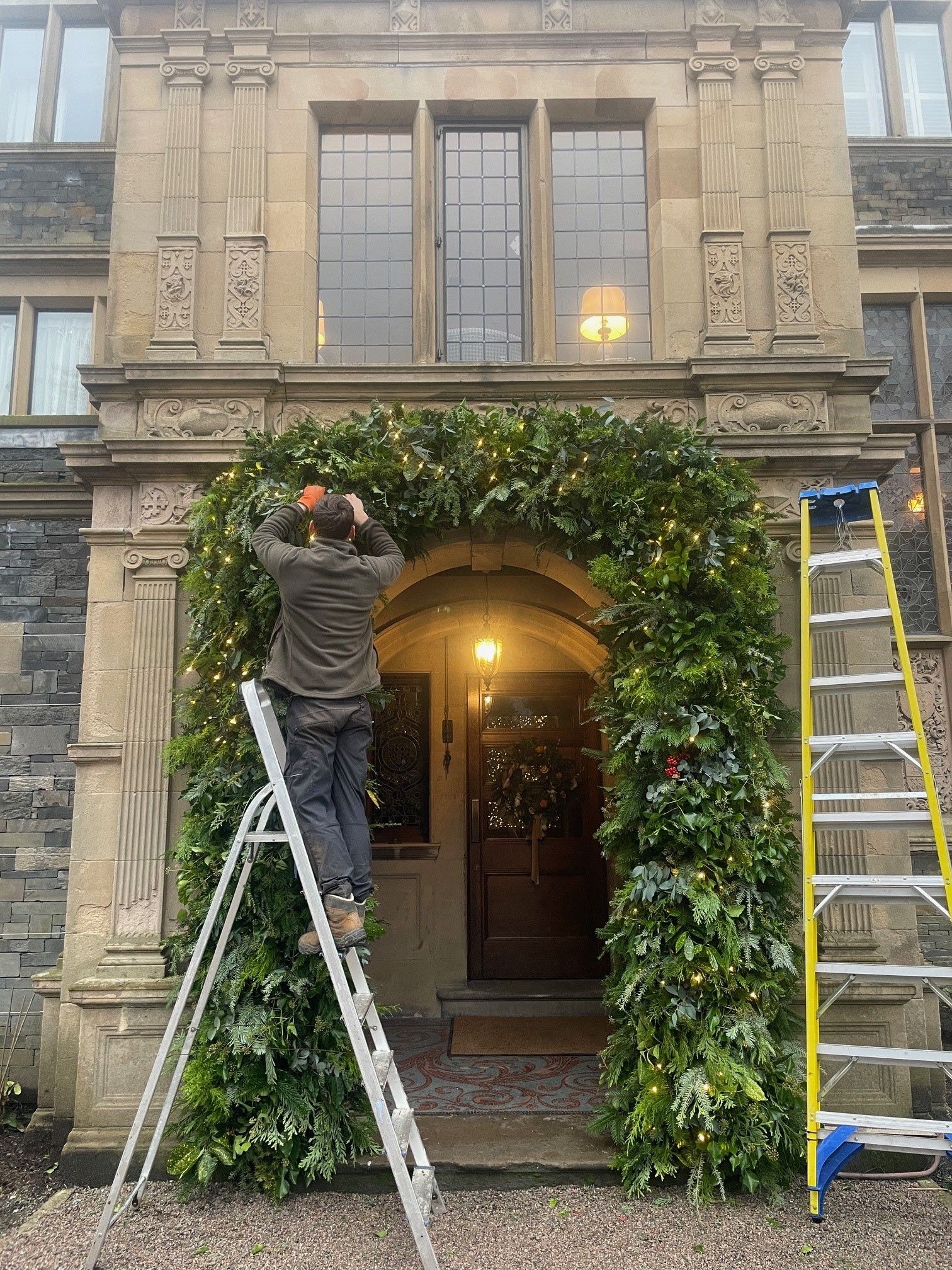
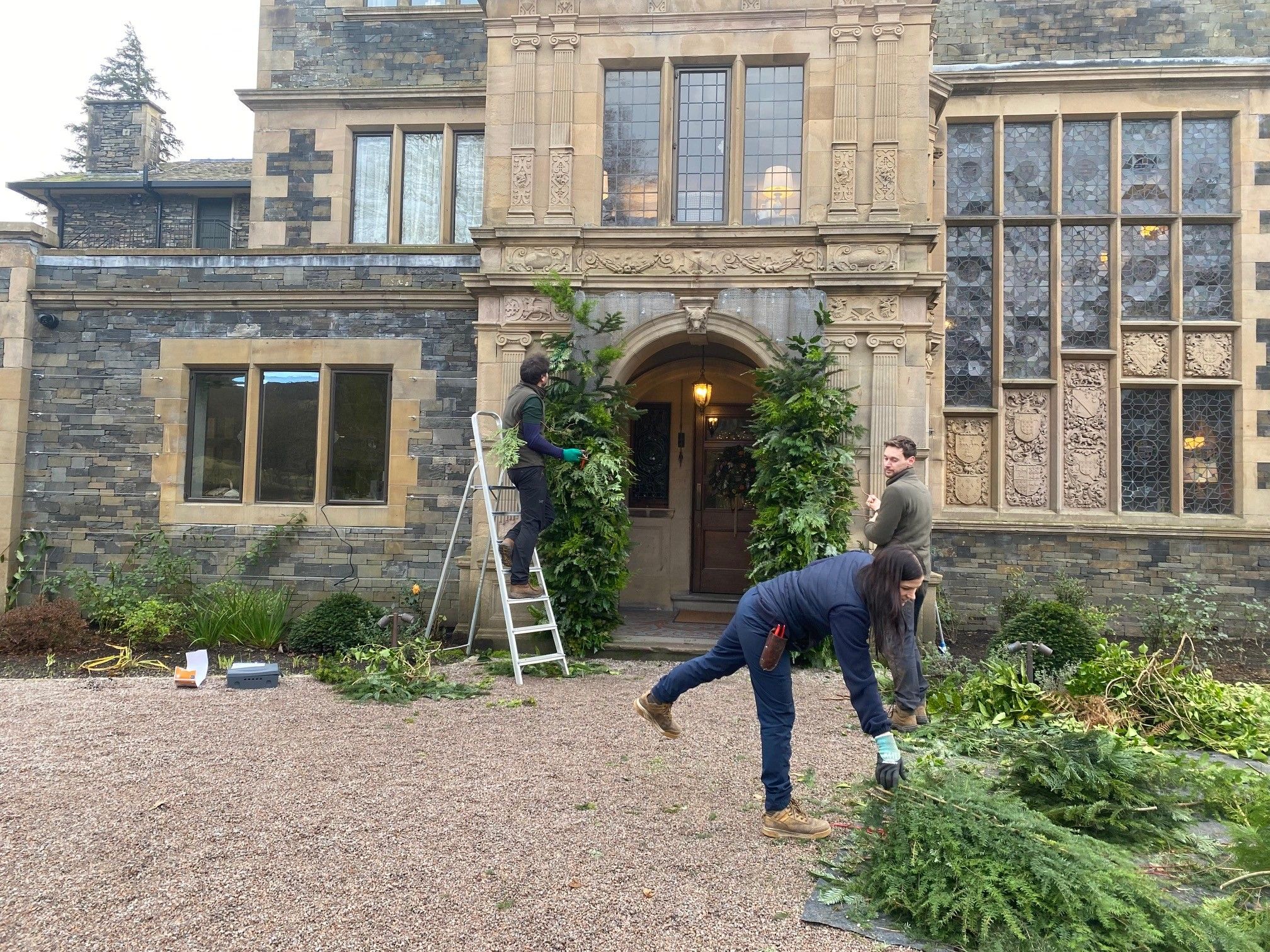




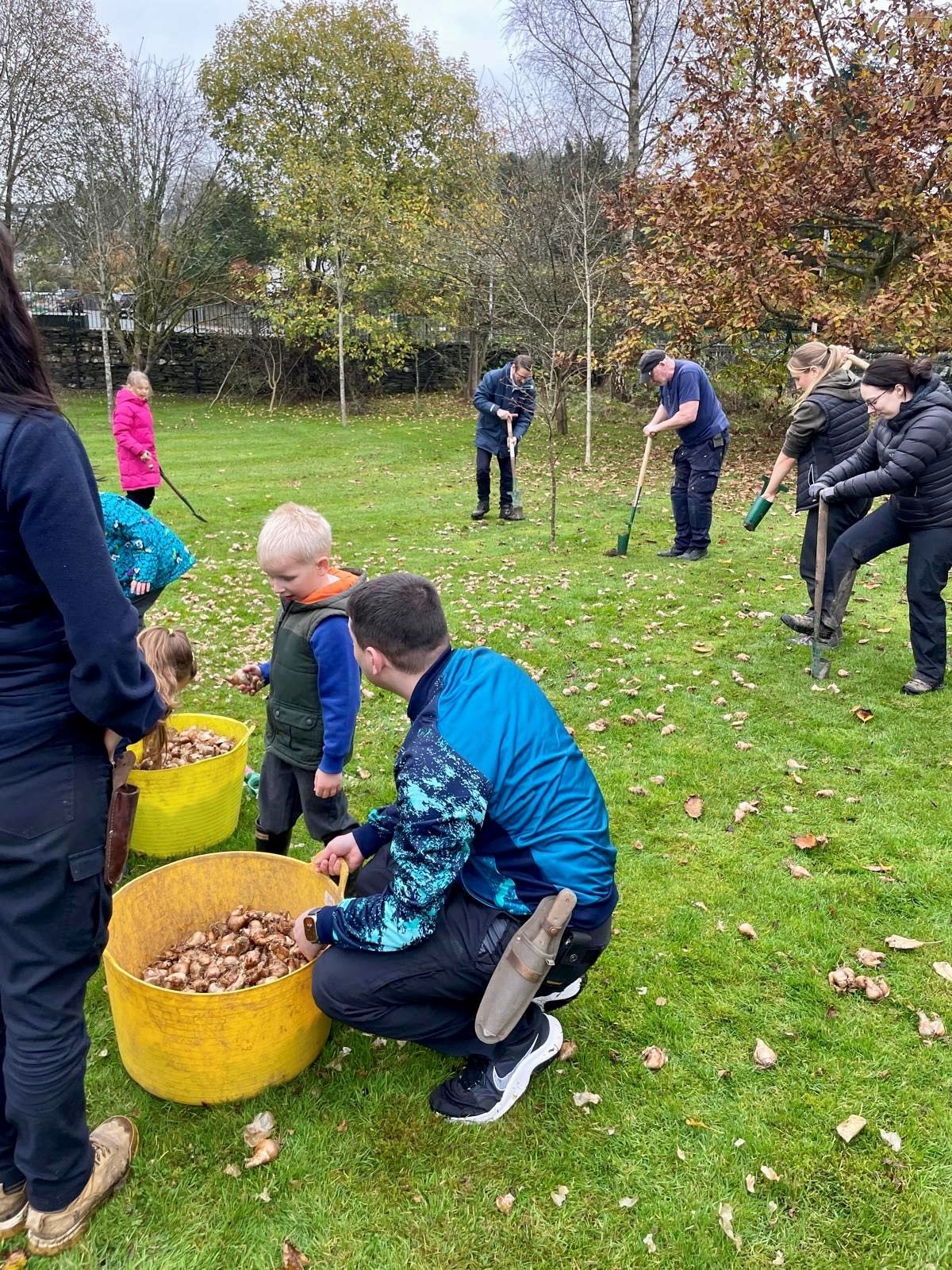
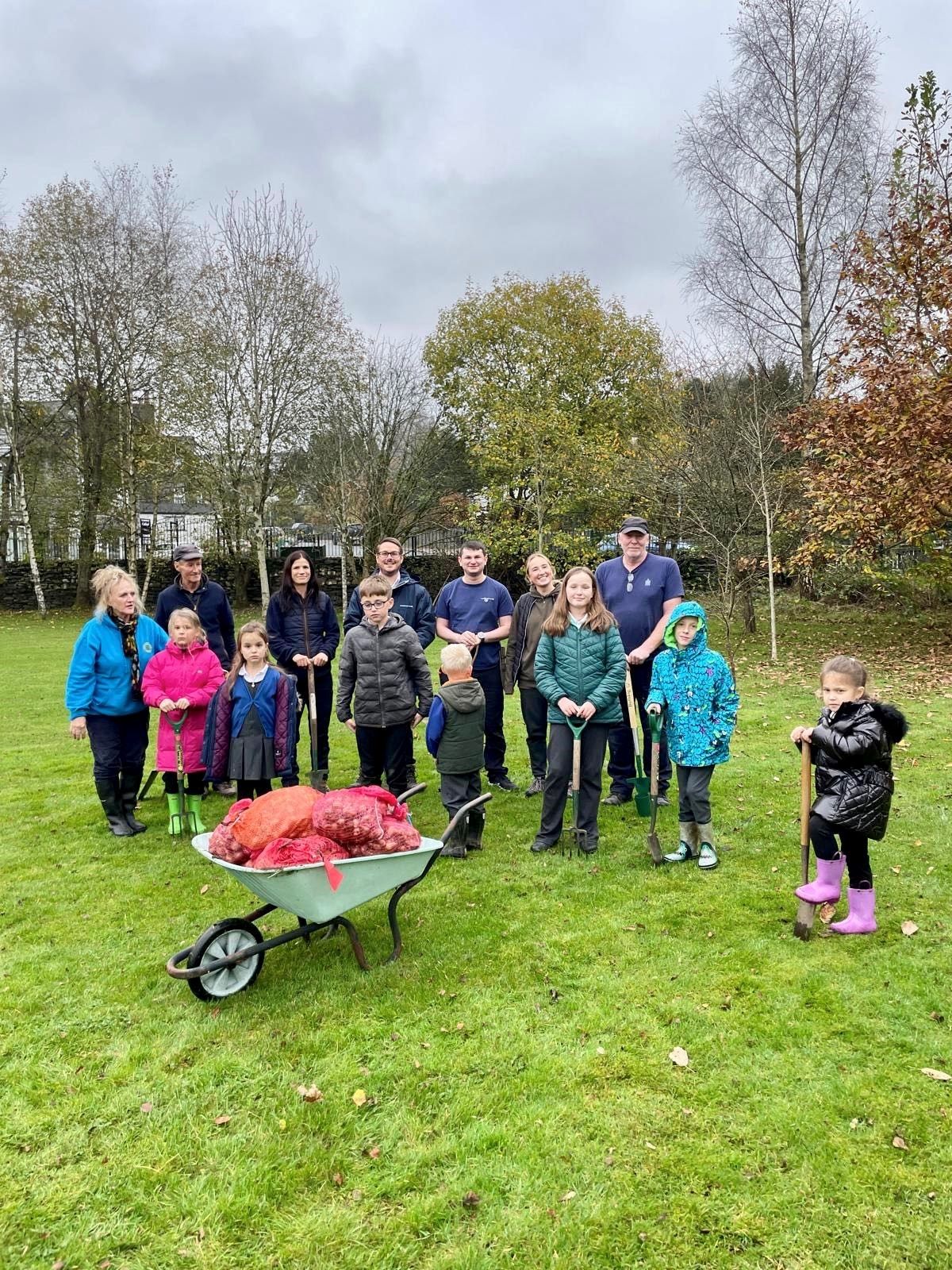


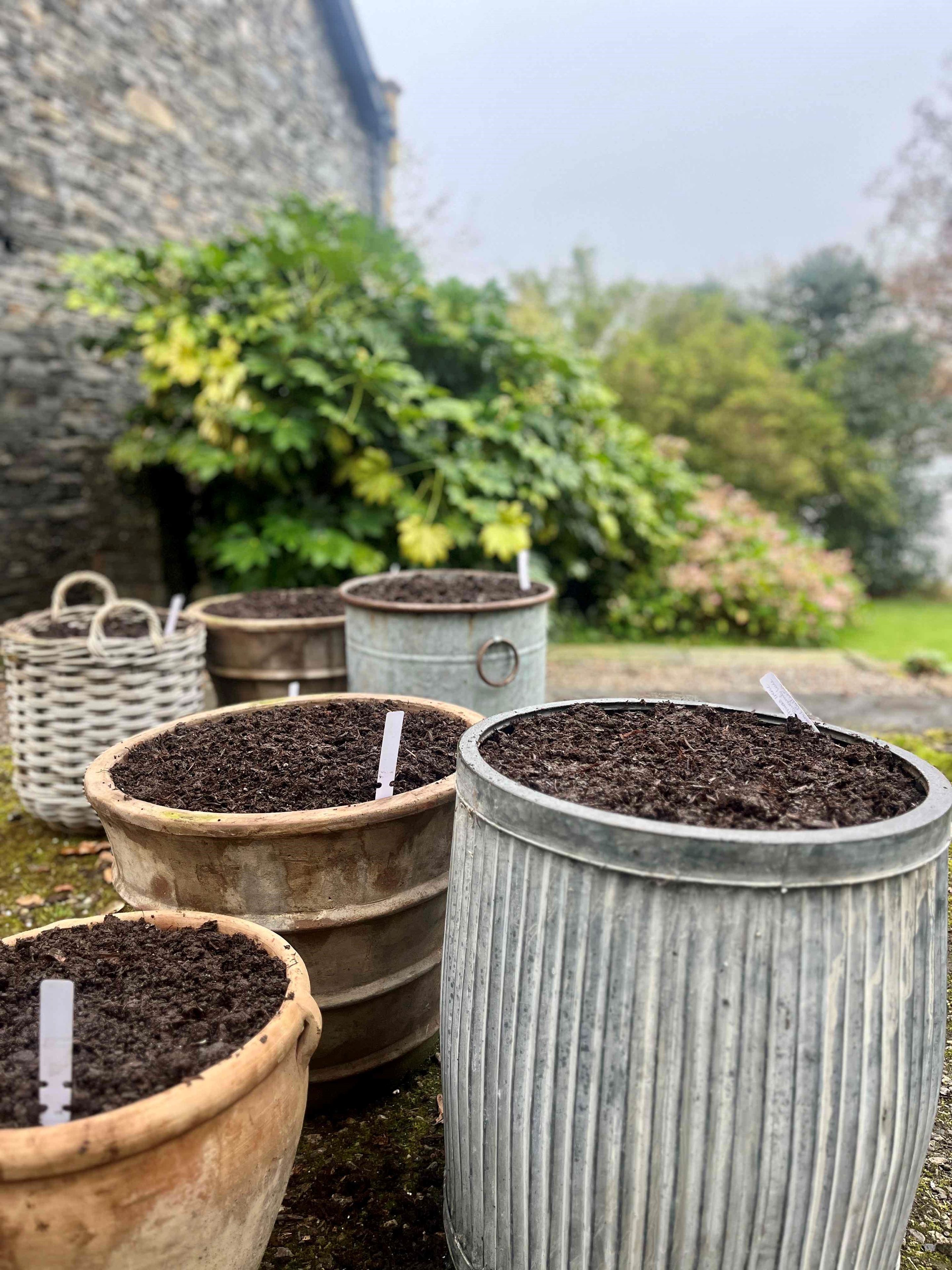

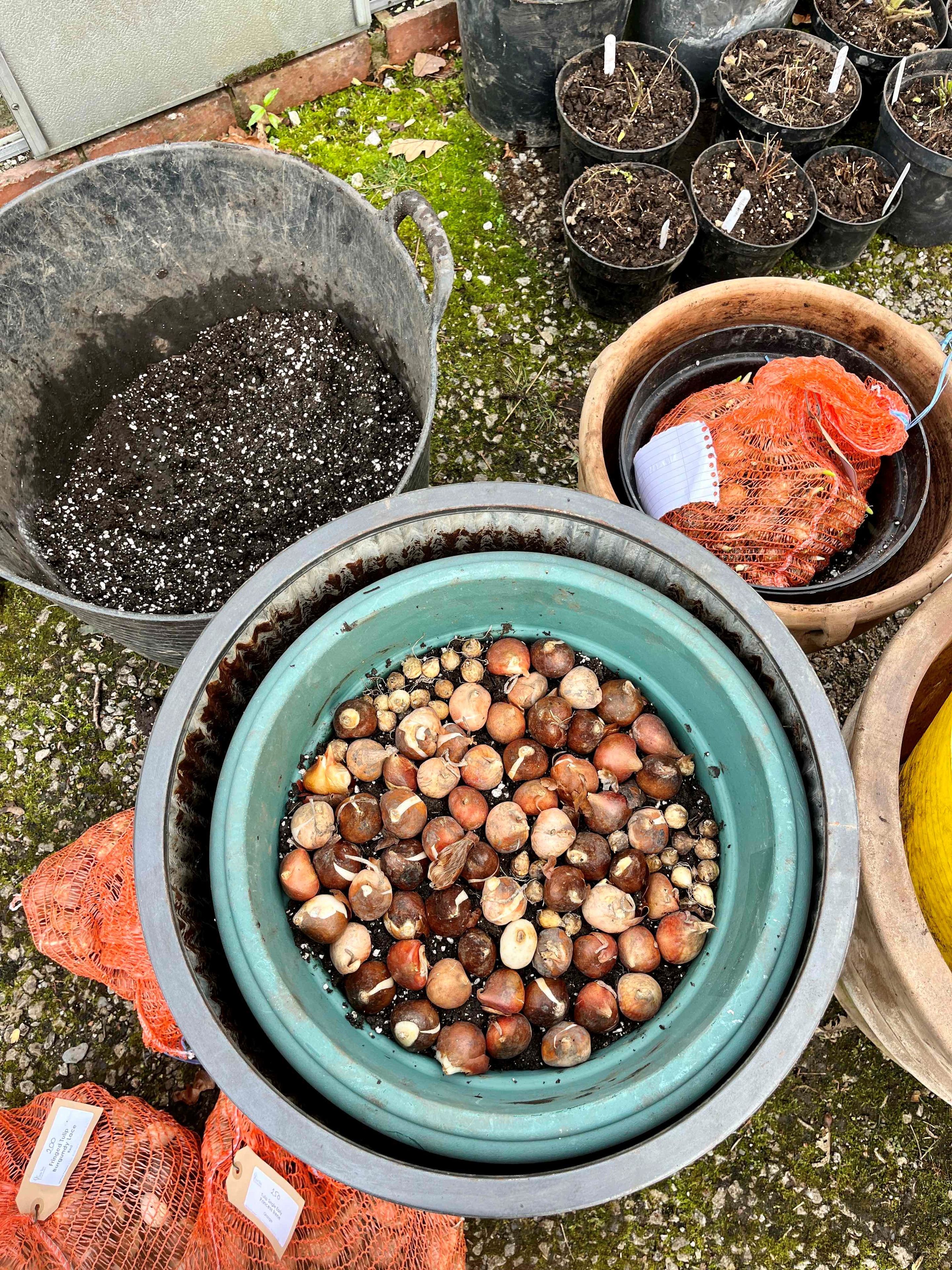



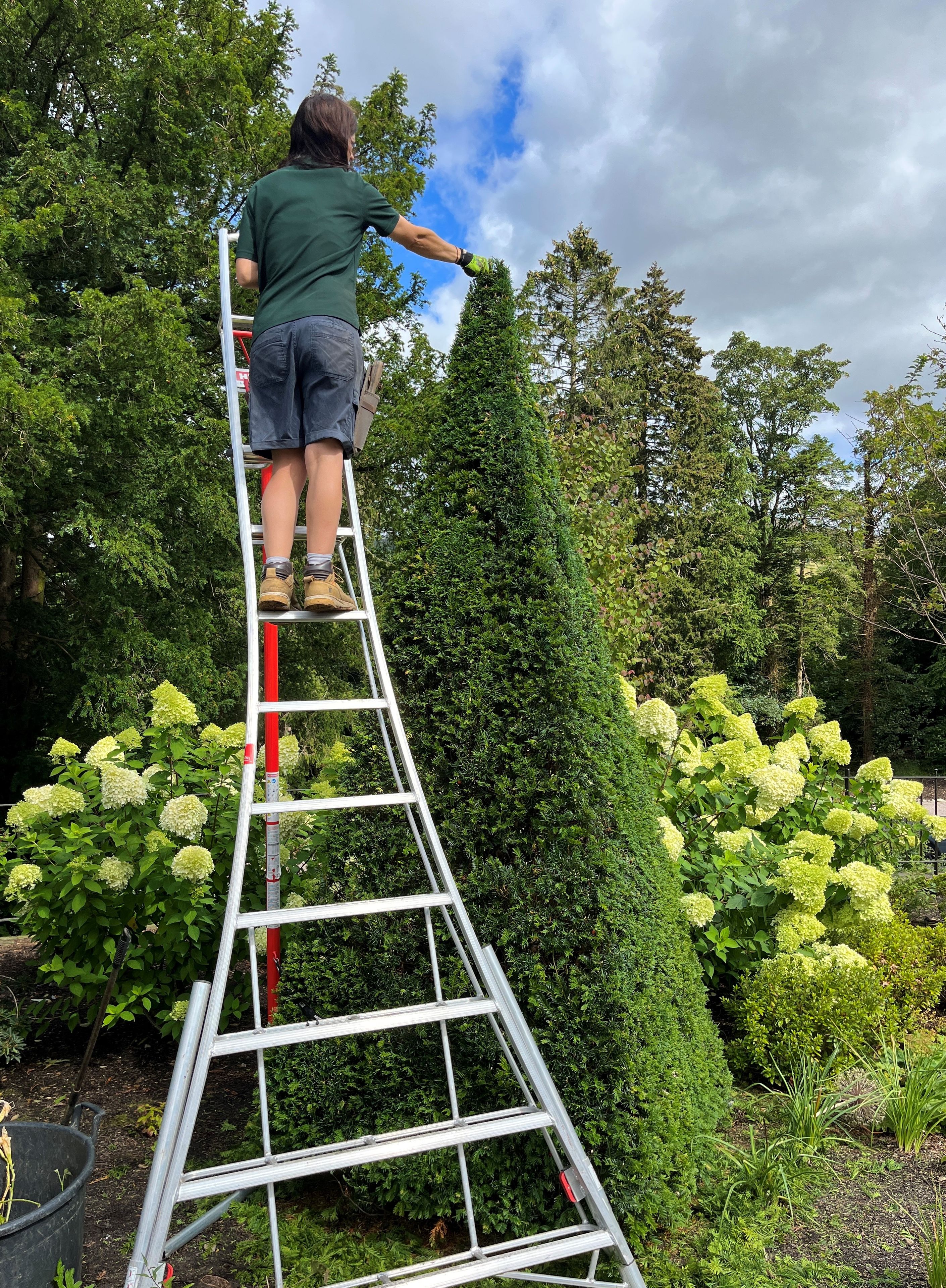
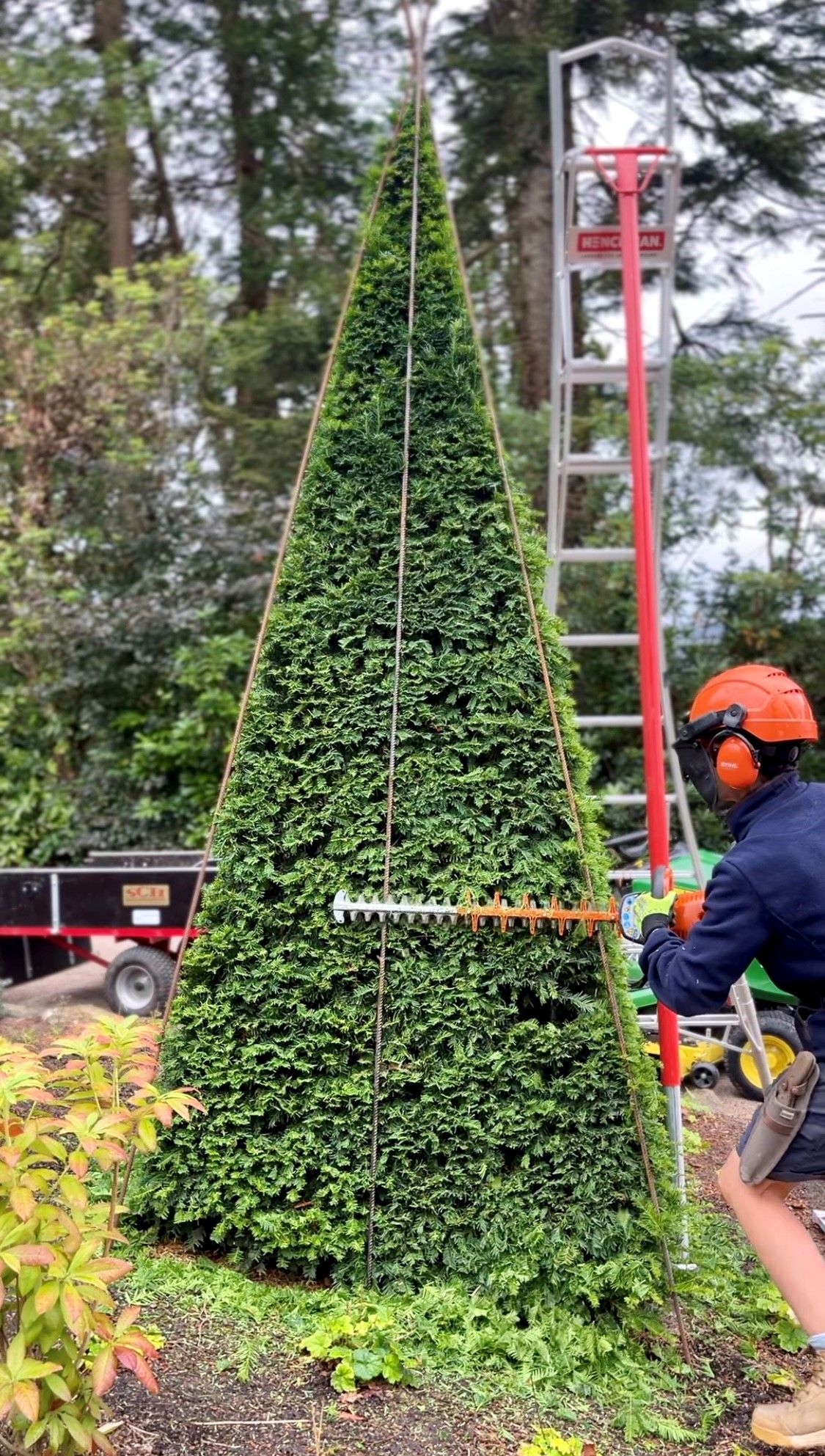


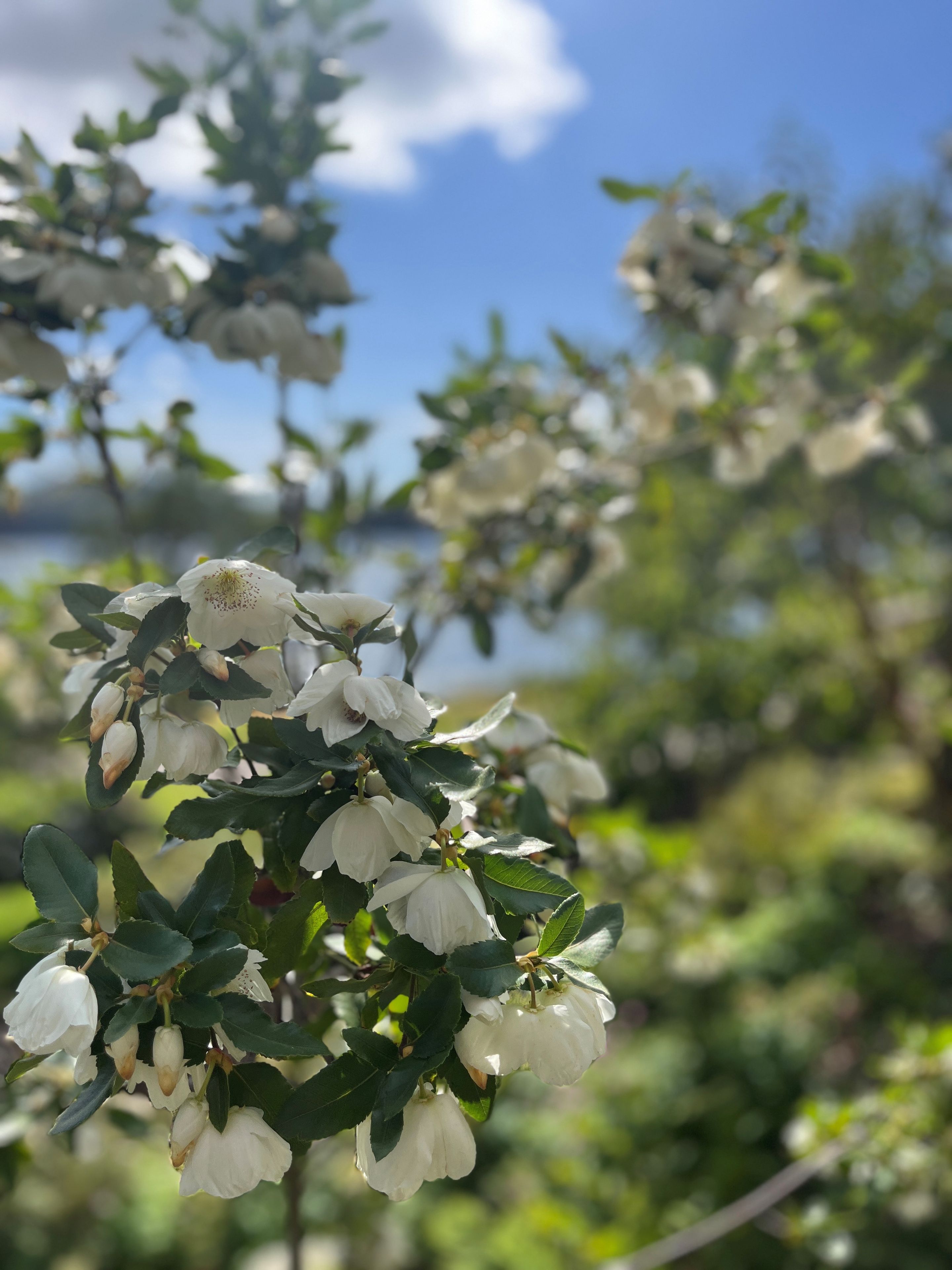



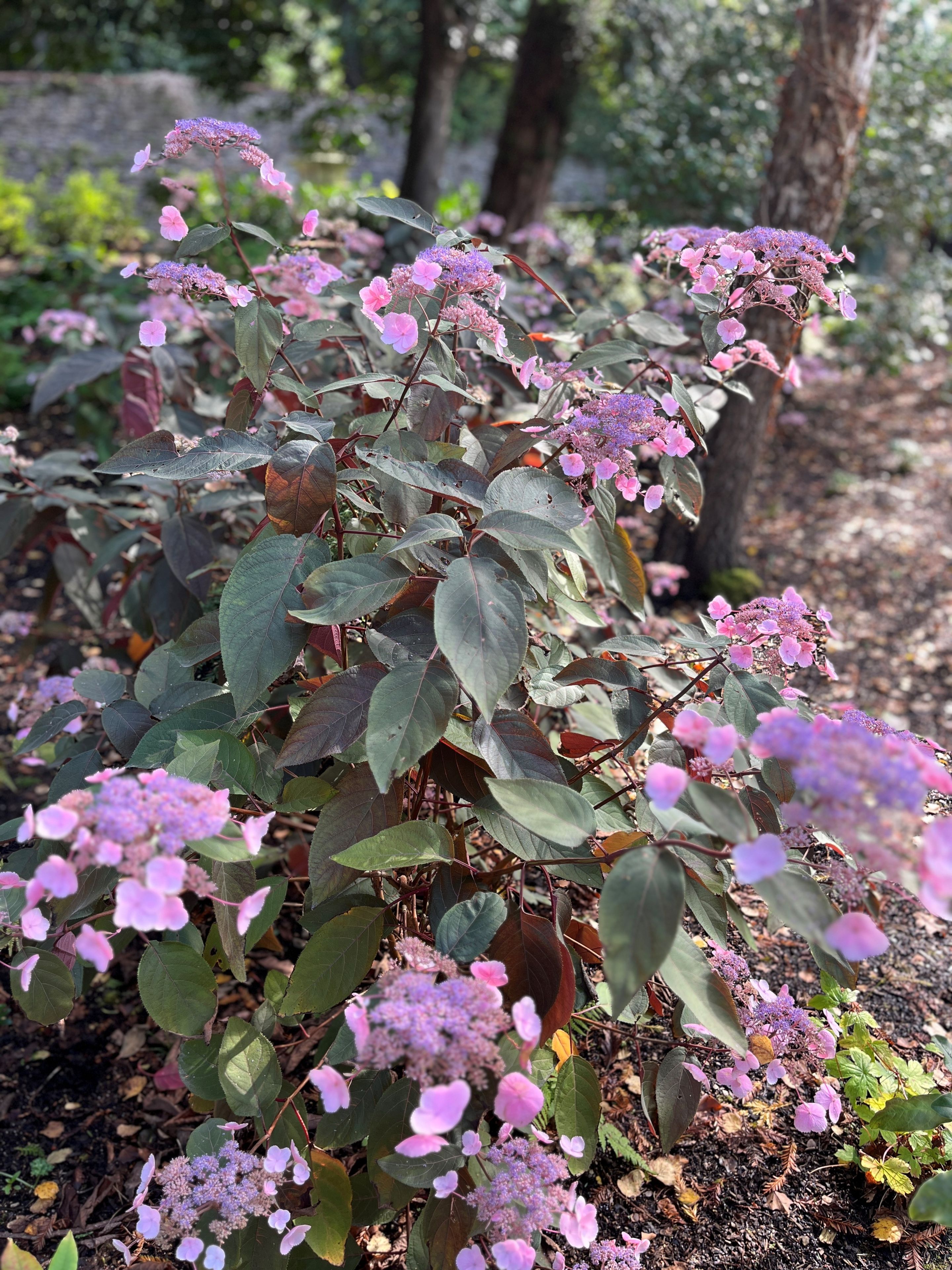



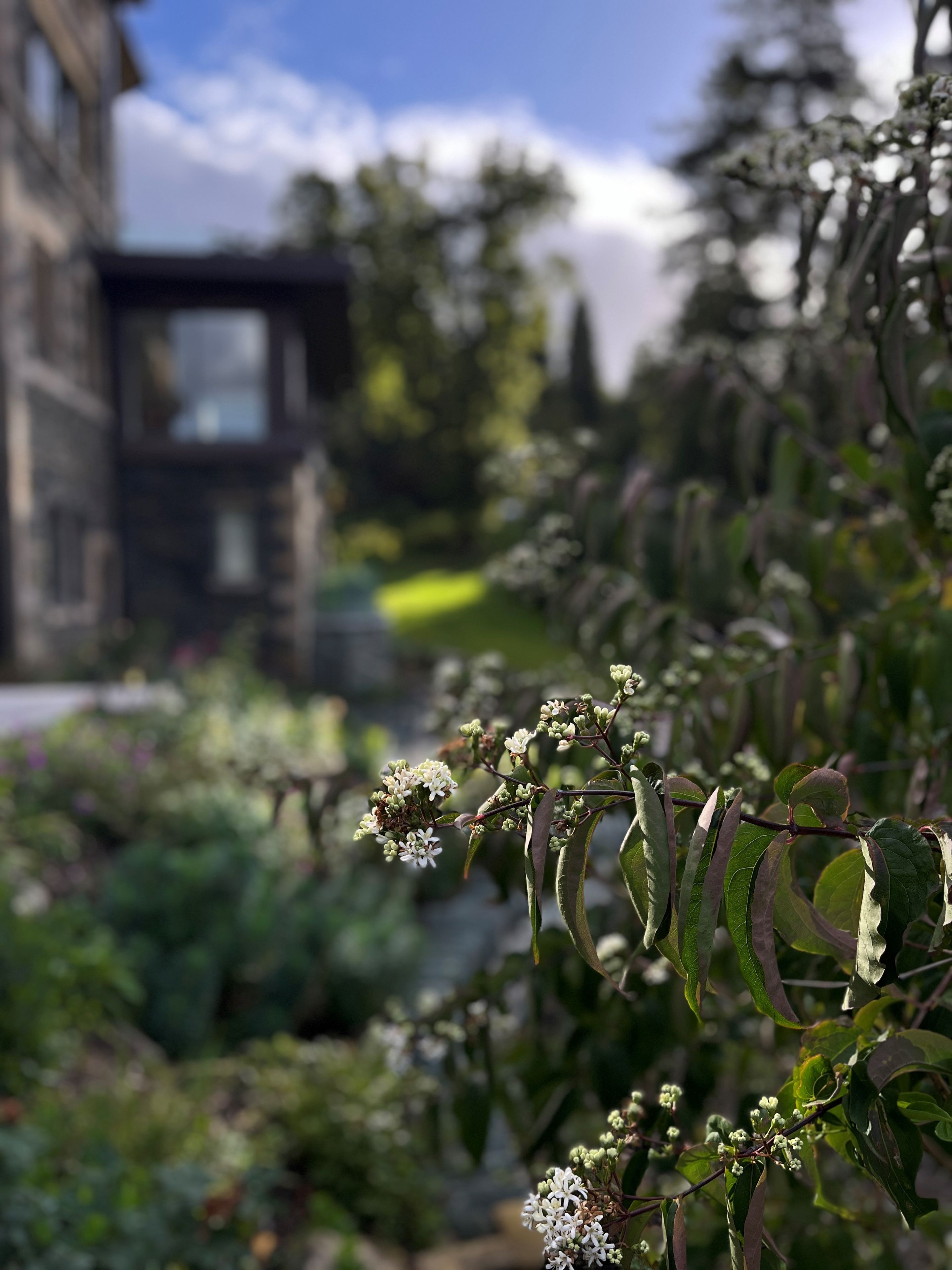
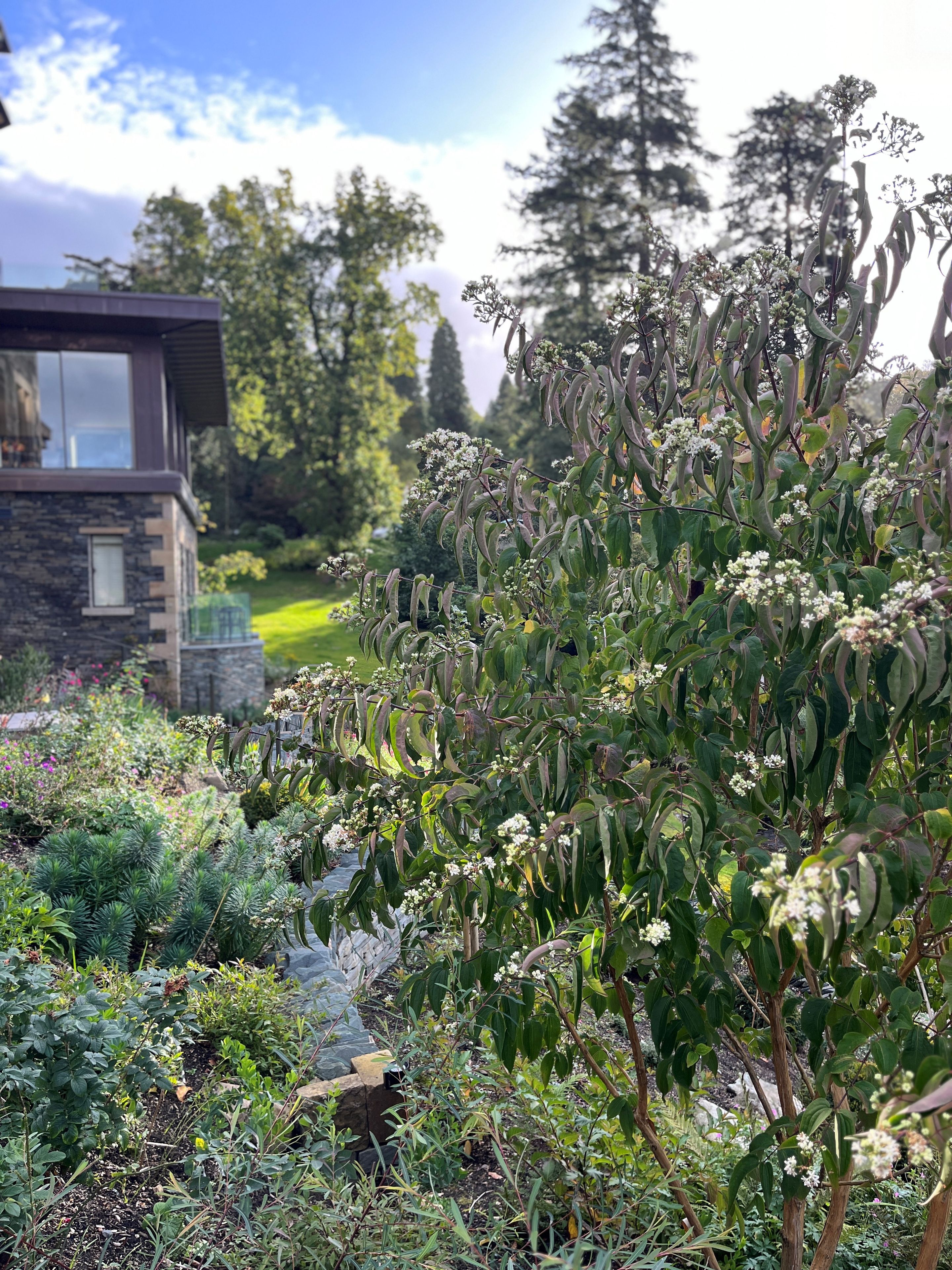



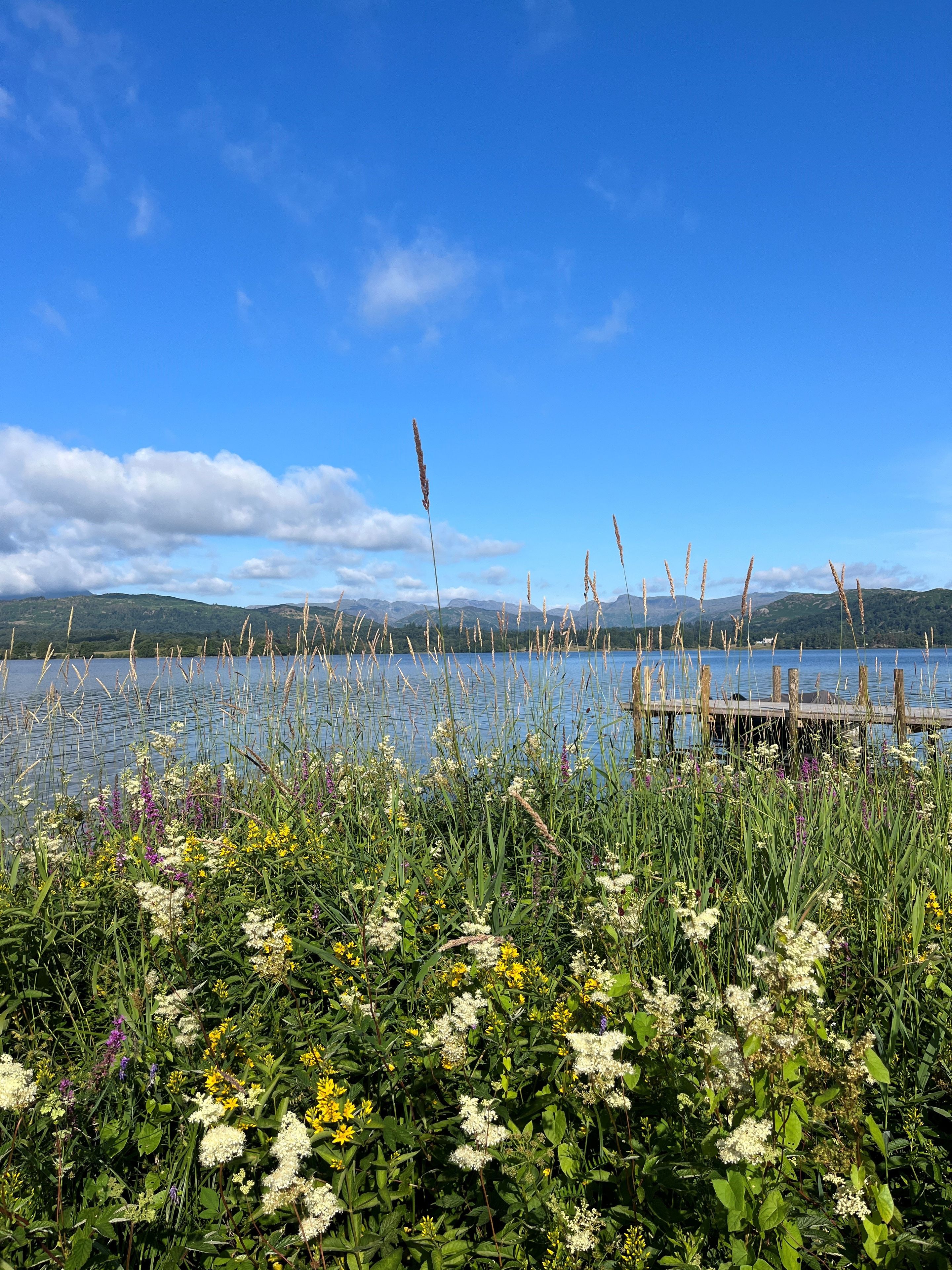
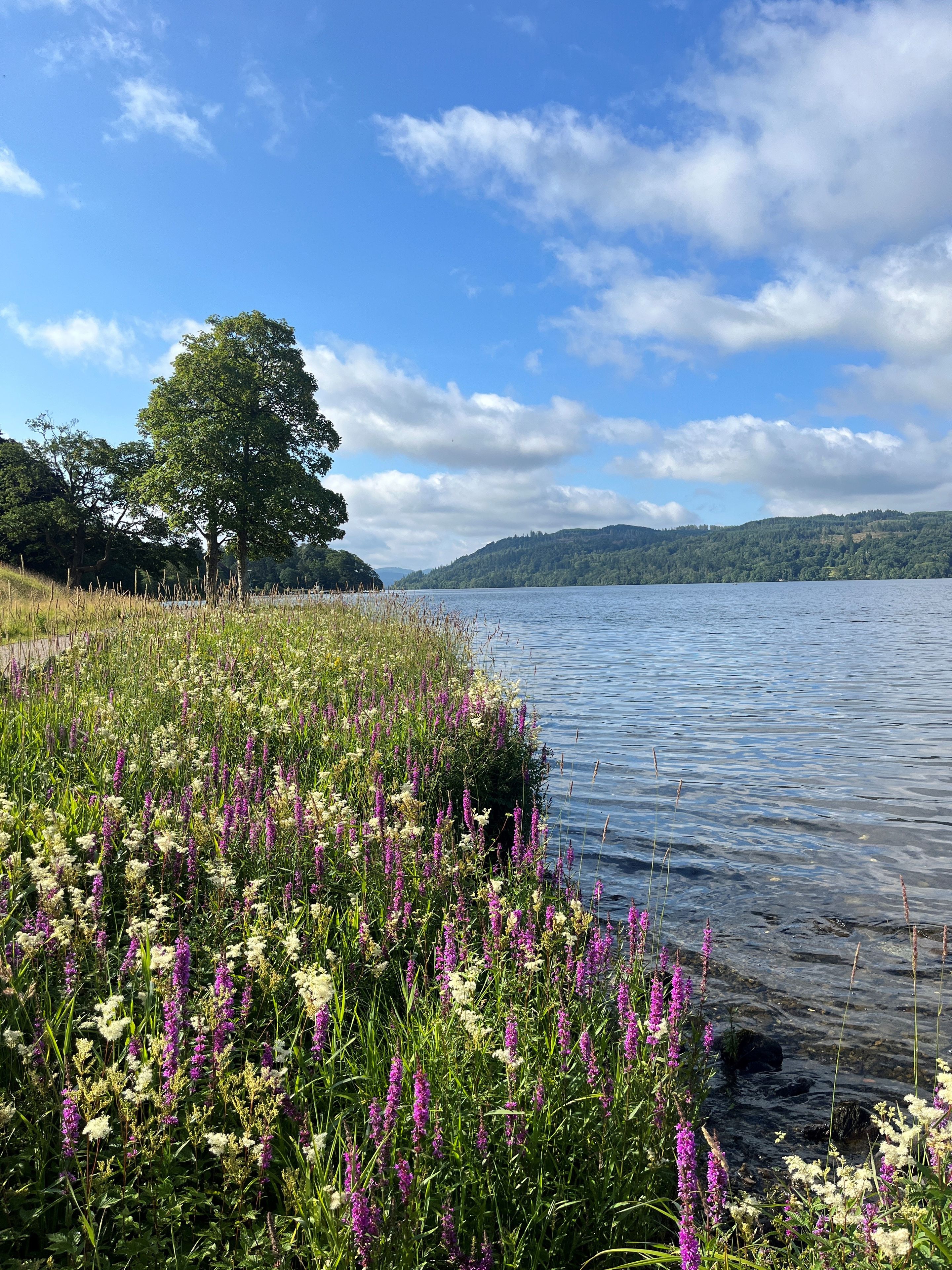


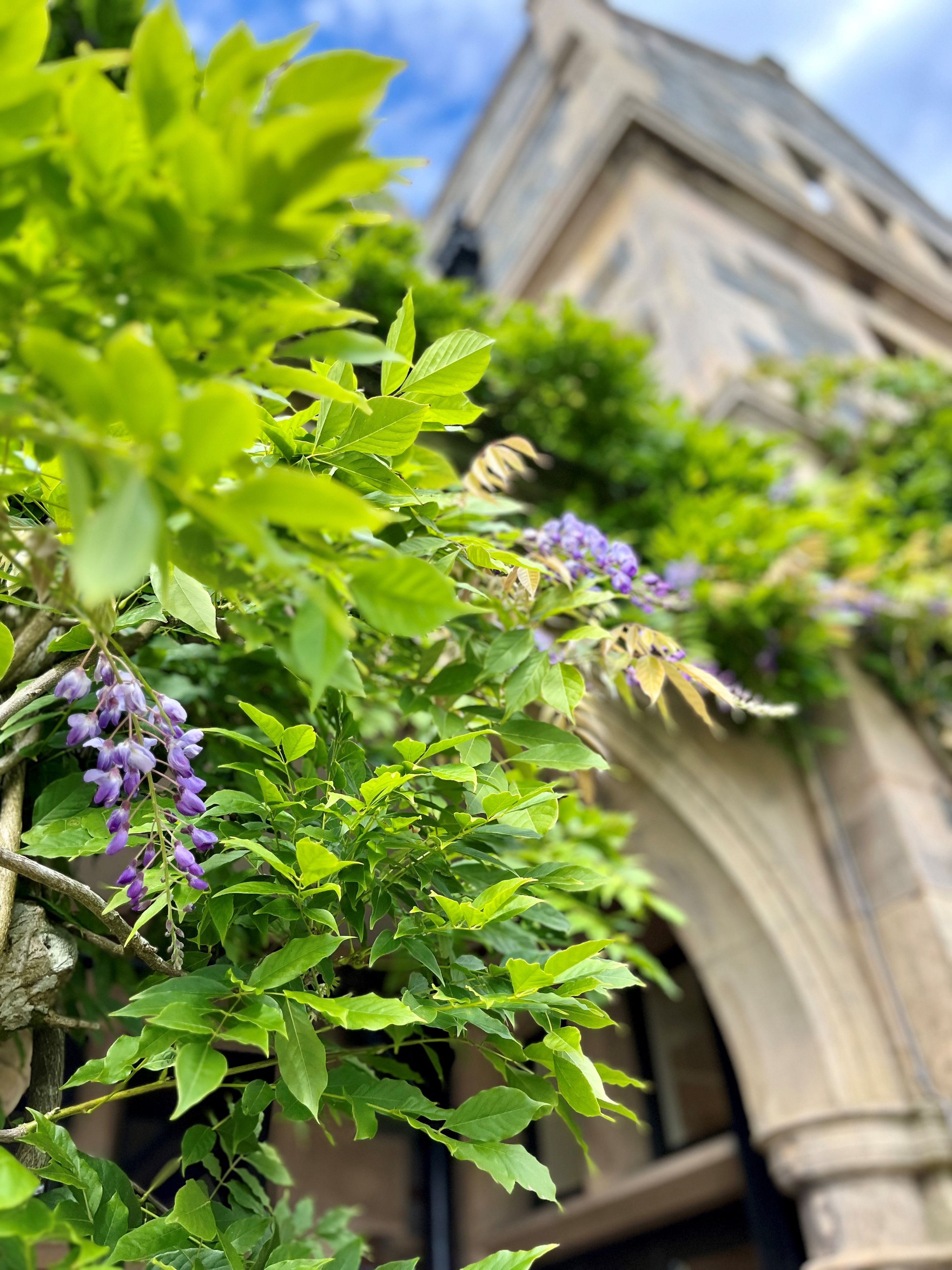
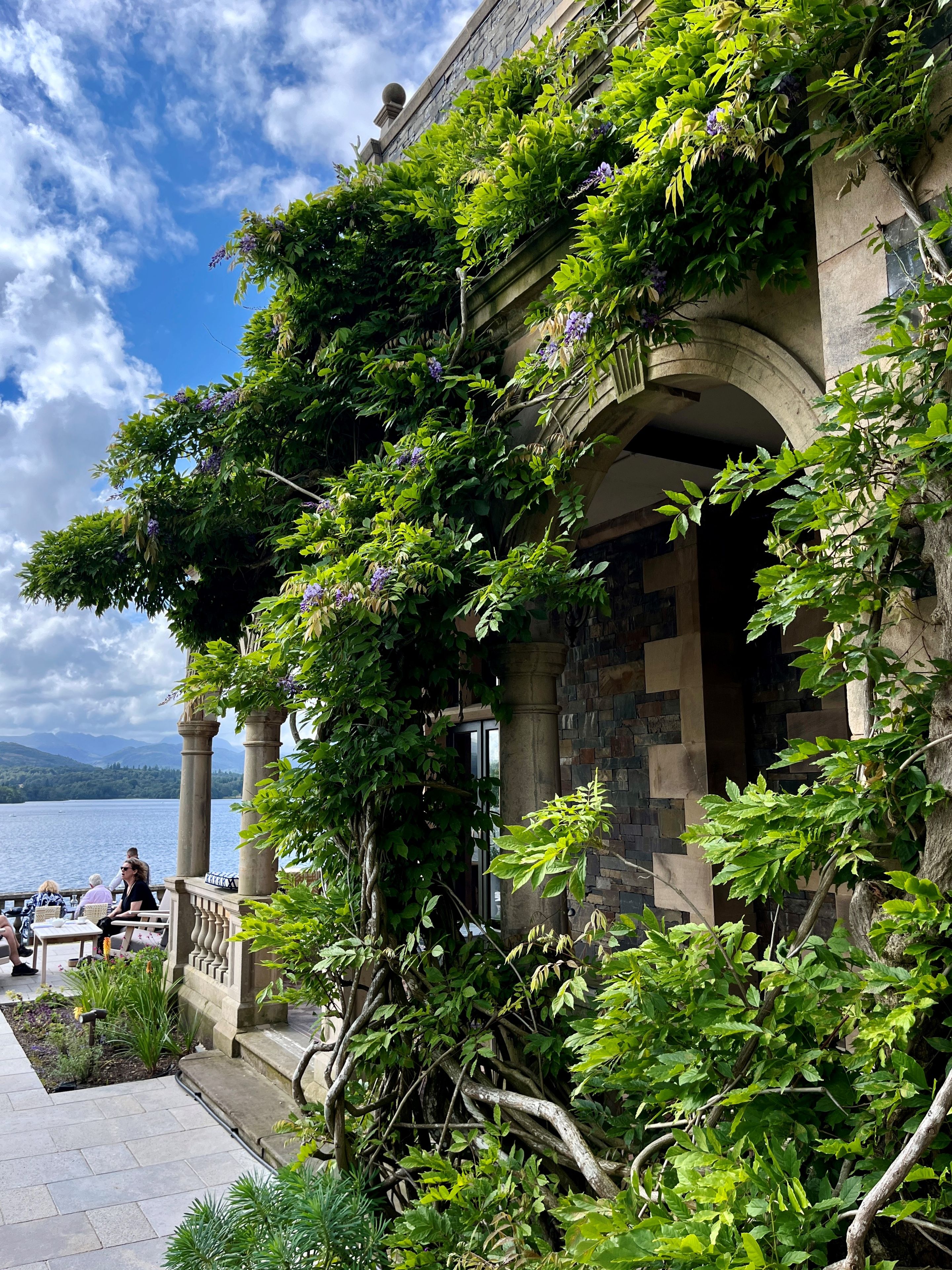


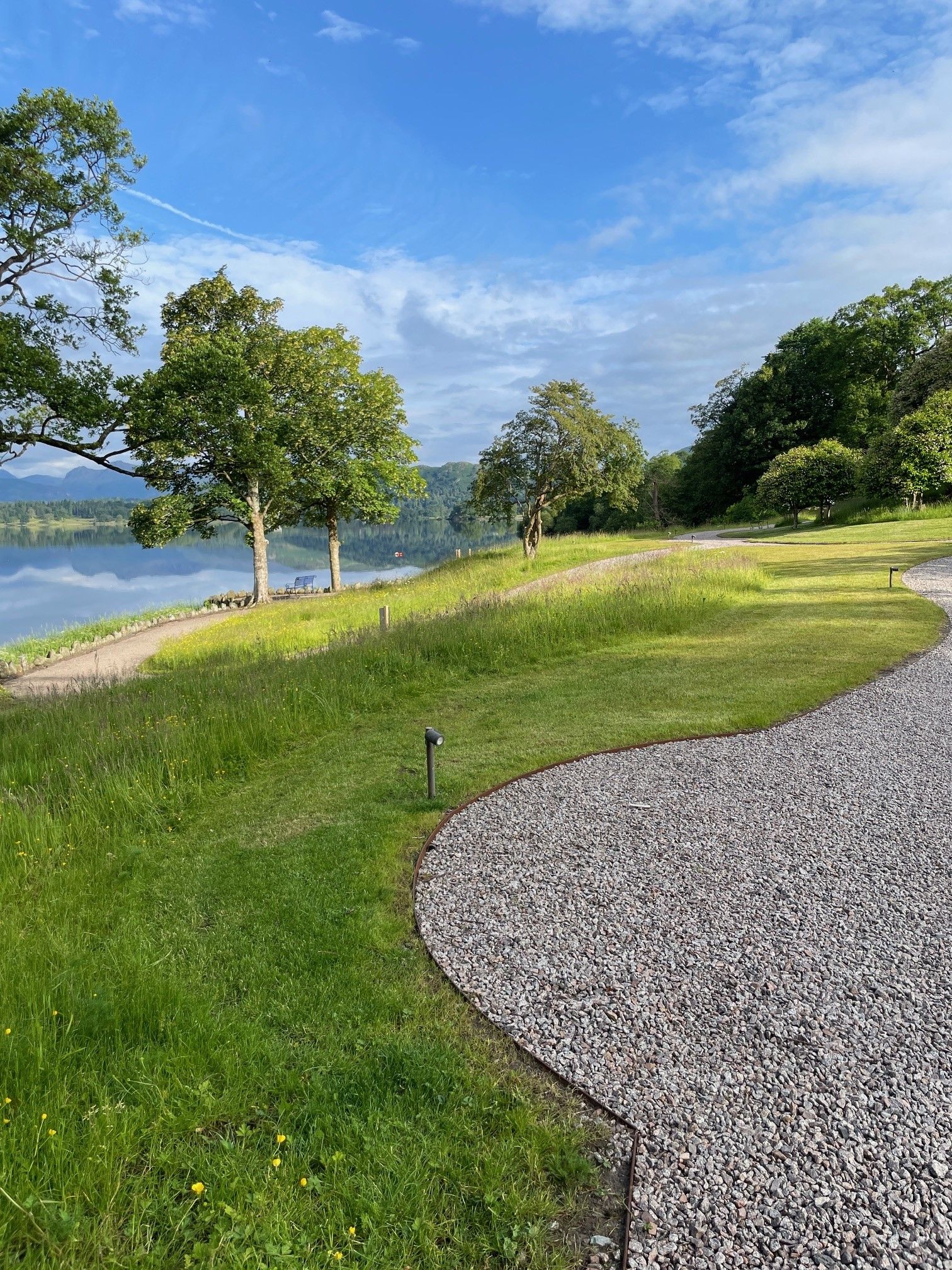
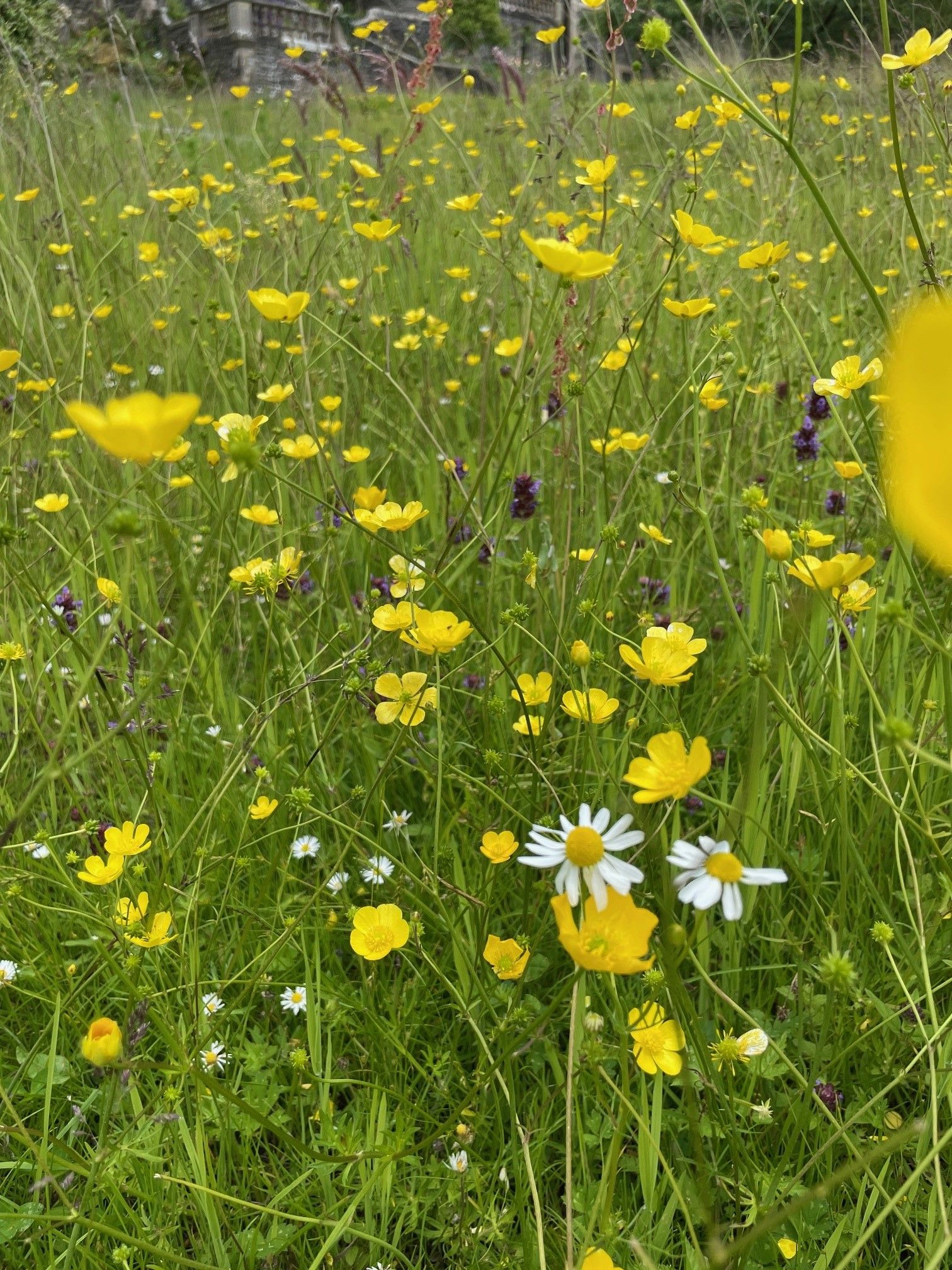
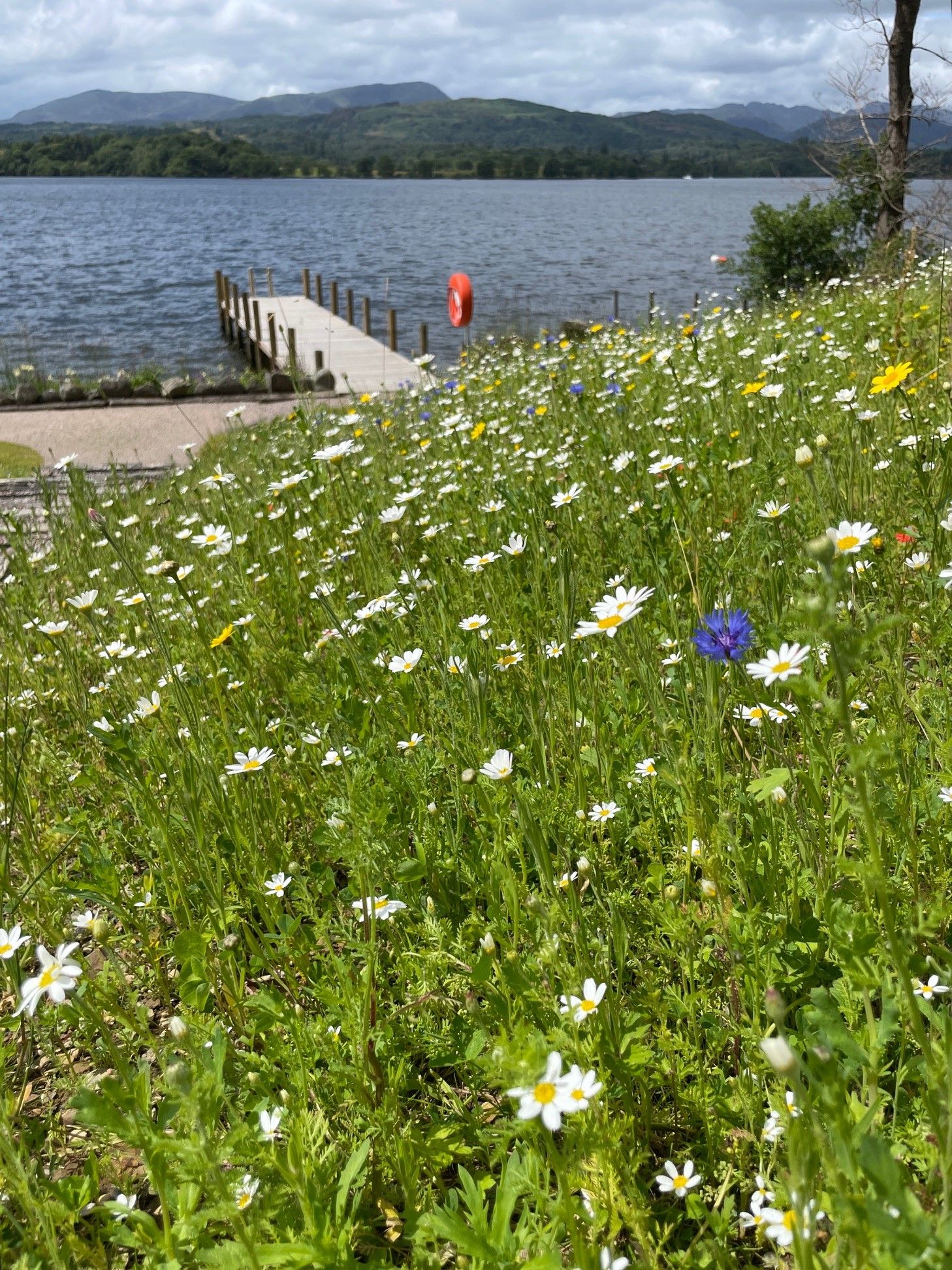


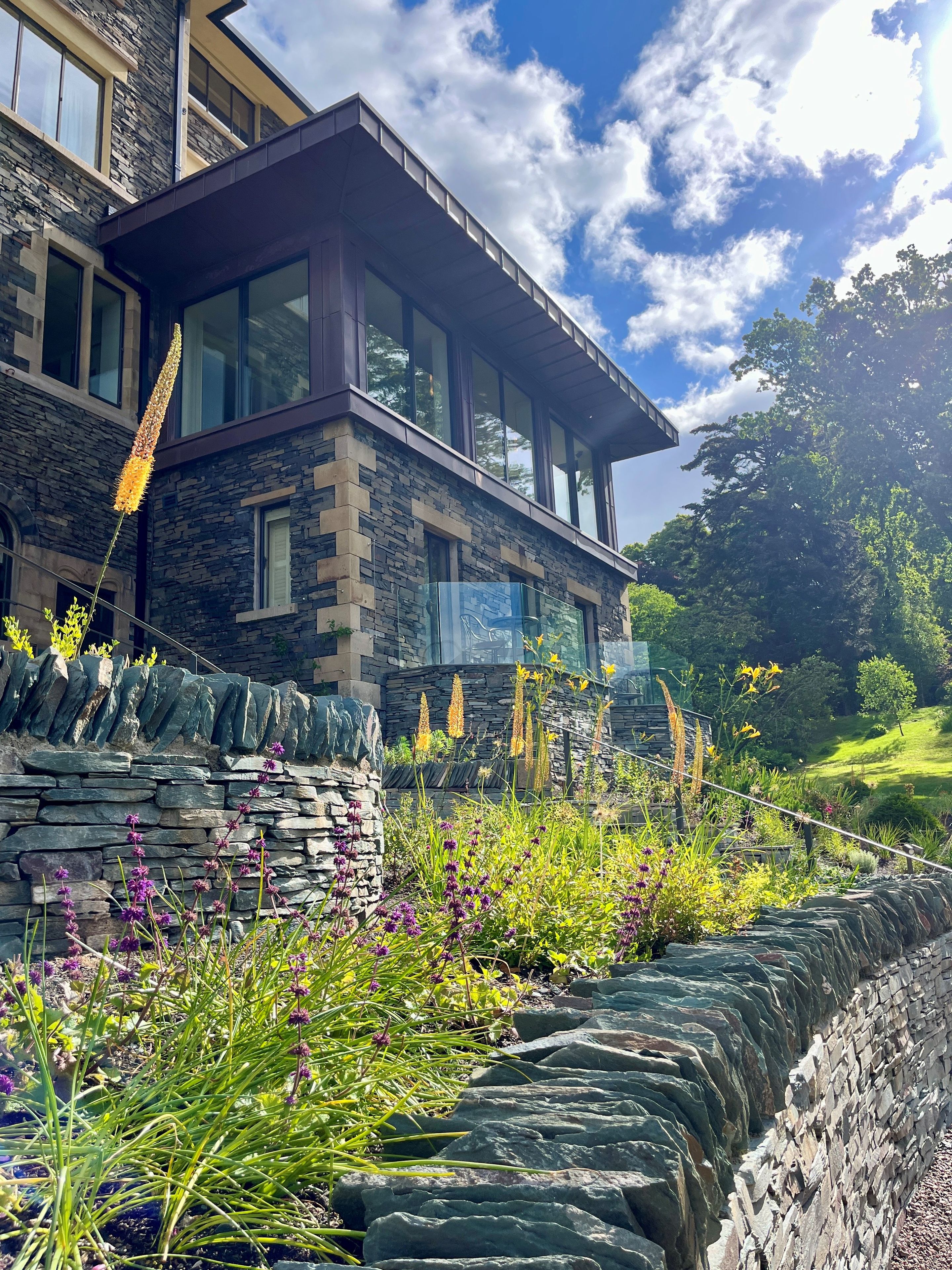

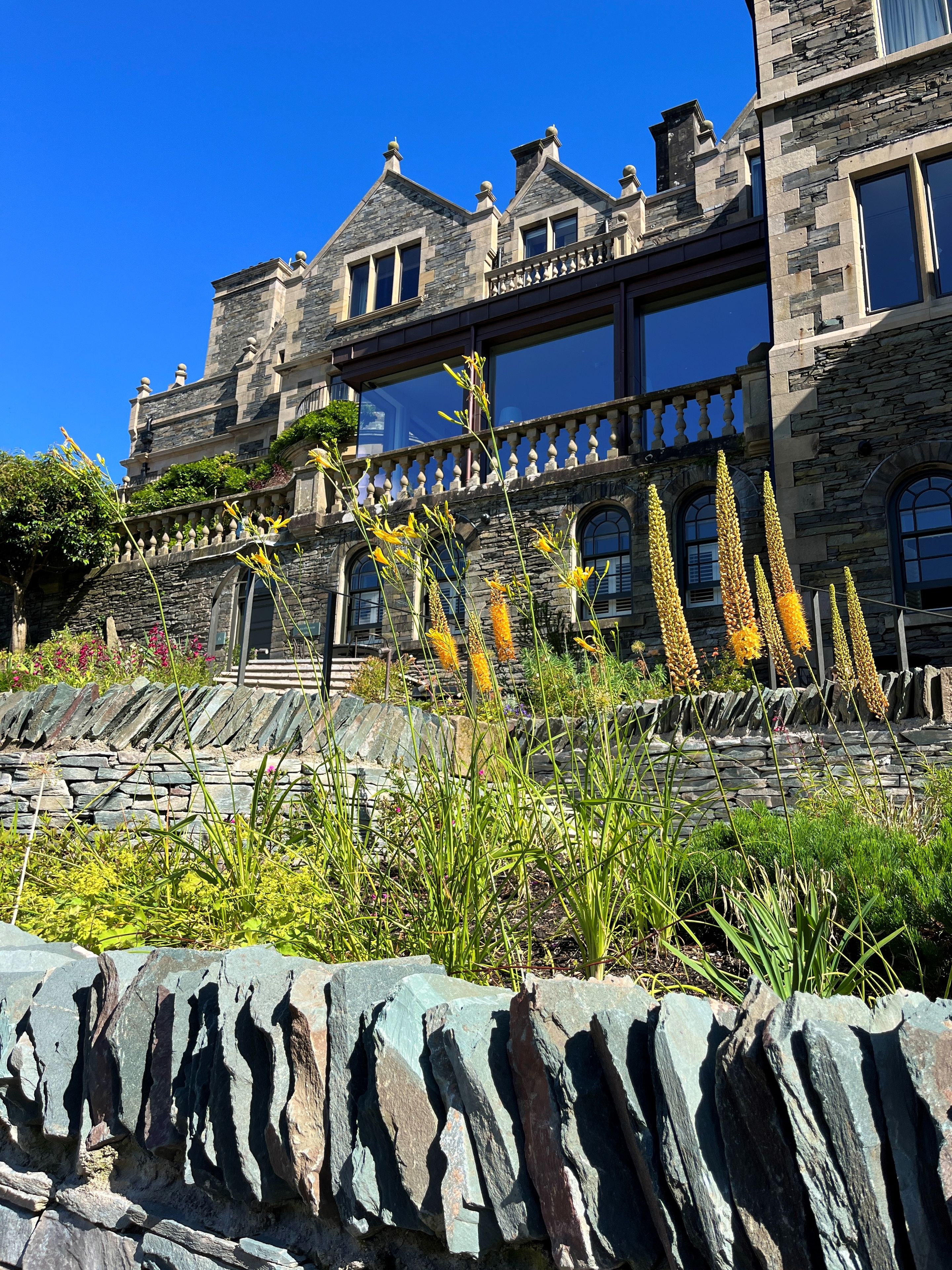











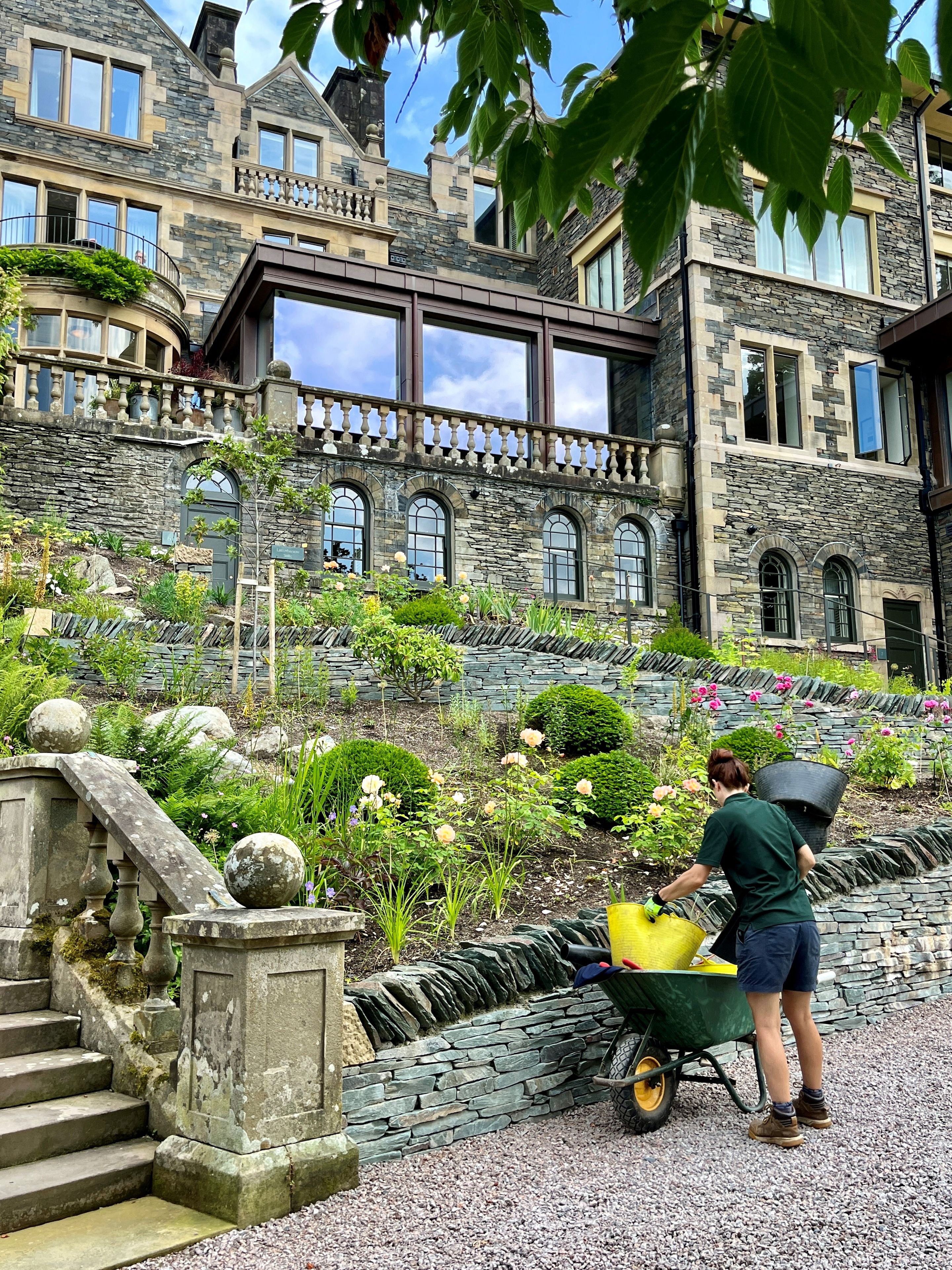
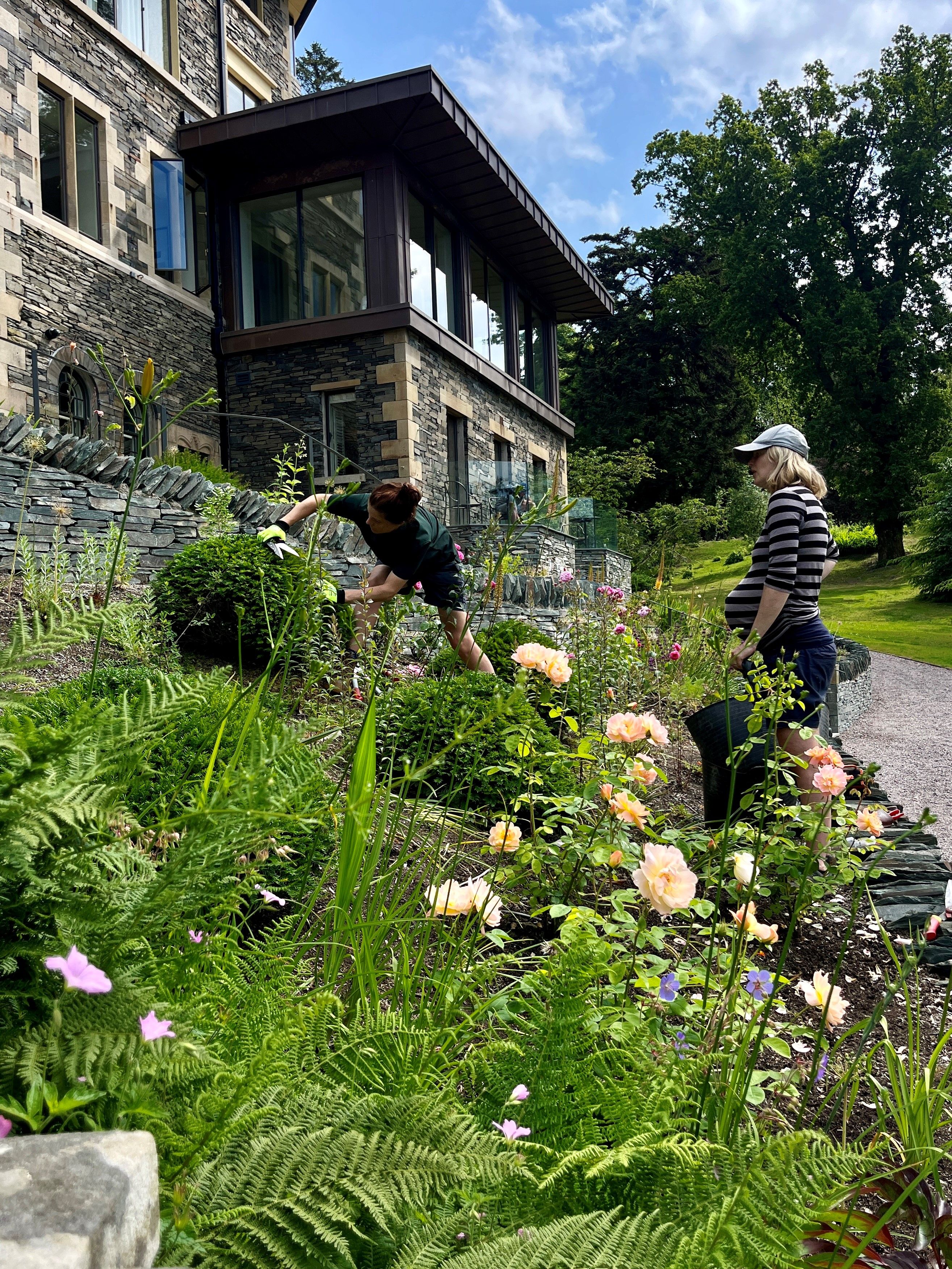


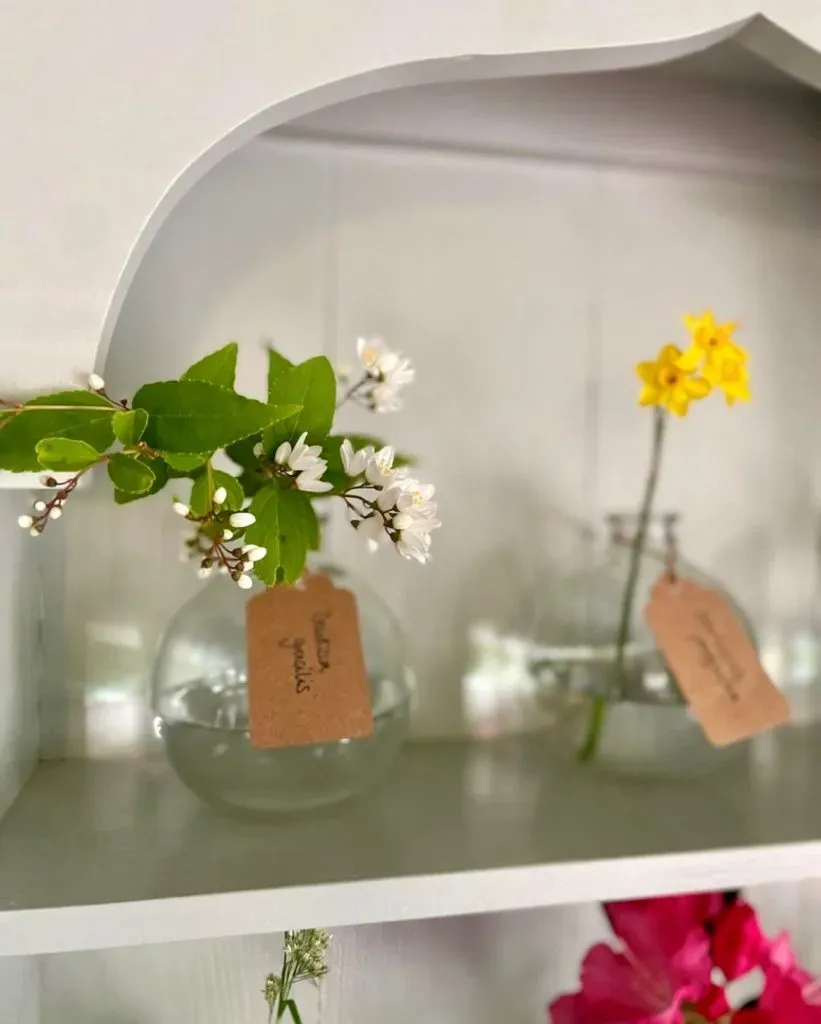
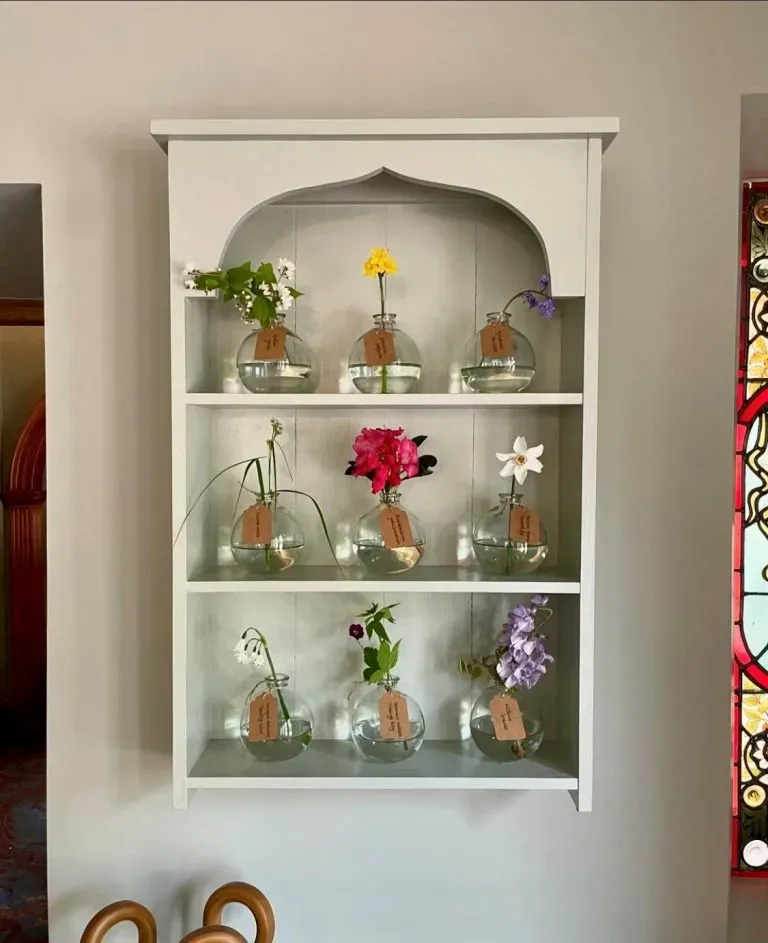


The newly planted Crataegus is now in flower, it is a pink form of the common native (white) Hawthorn which is usually found in hedgerows. We’re really appreciating its late spring colour, which lines the pathways leading from the hotel to the car park.
– Alex


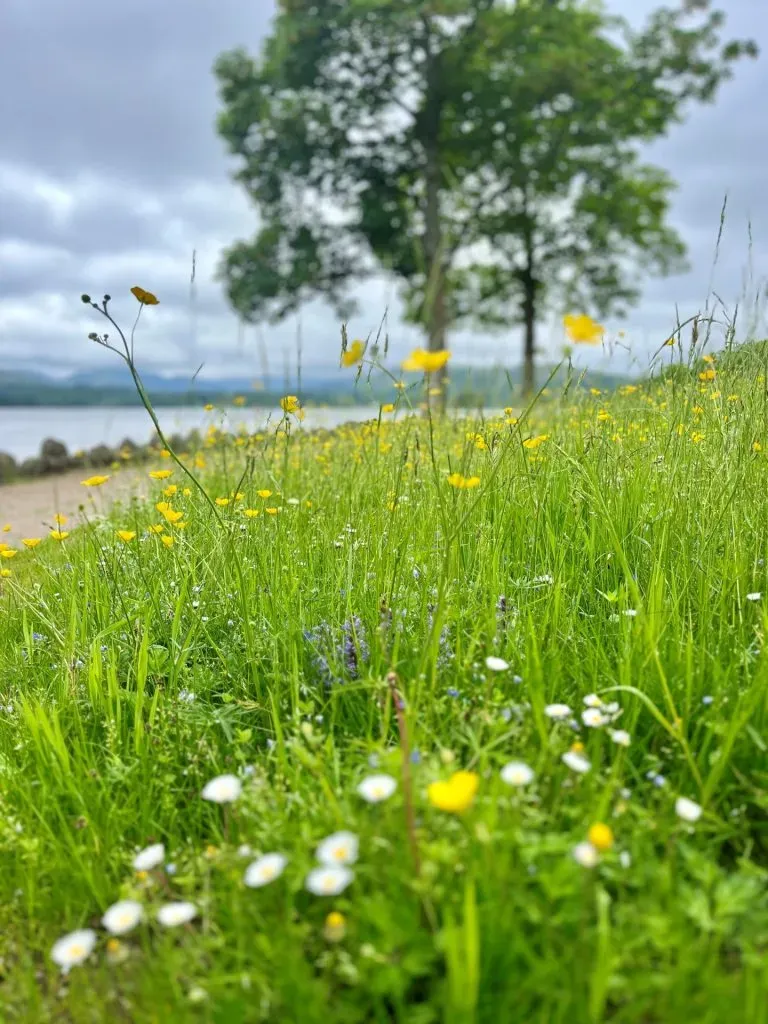
In an effort to increase biodiversity and habitats for pollinators, we are allowing meadows to form along the lakeside.
These will be delineated from the lawns with a crisp mown edge, to strike a balance between nature and the manicured garden. Although this gives us some relief from of our mowing duties, it does take some management to remove vigorous species that would usually dominate other wildflowers.
Keep an eye out for: Conopodium majus, Cardamine pratensis, Veronica camaedrys, Ajuga reptans, Trifolium repens and lotus corniculatus.
– Alex
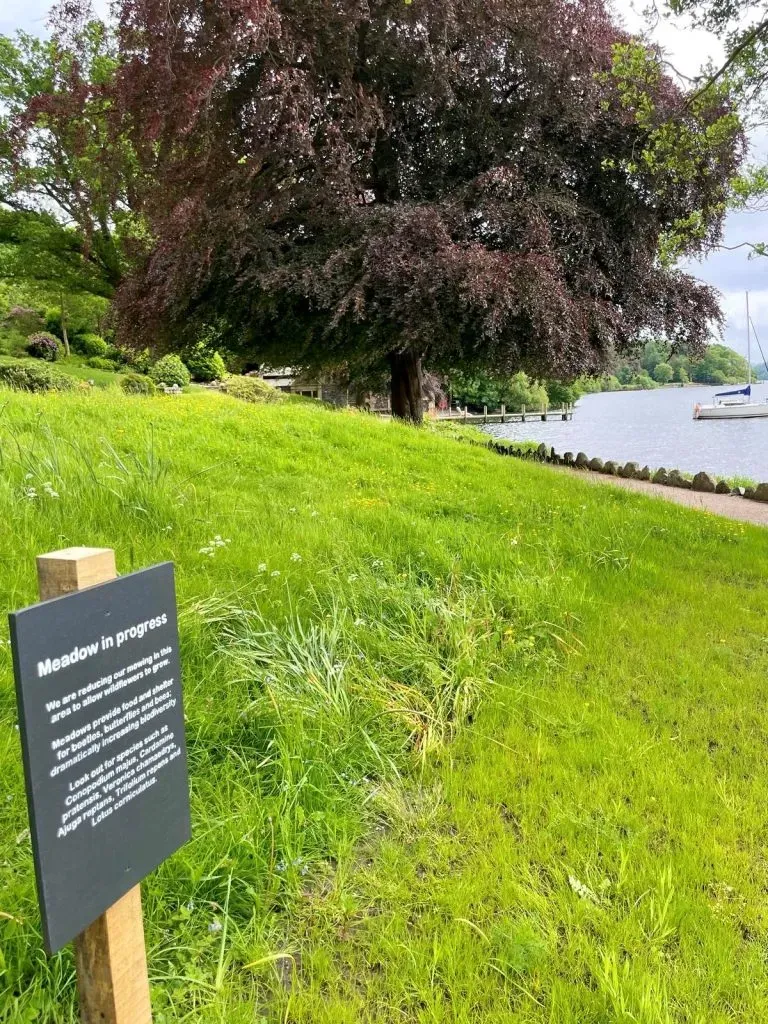


The Camassia leichtinii ‘Alba’ has begun to flower, taking over from the blue form of Camassia which has now gone over as we leave spring behind. They have a great upright habit and bridge the gap between Spring and Summer.
– Alex
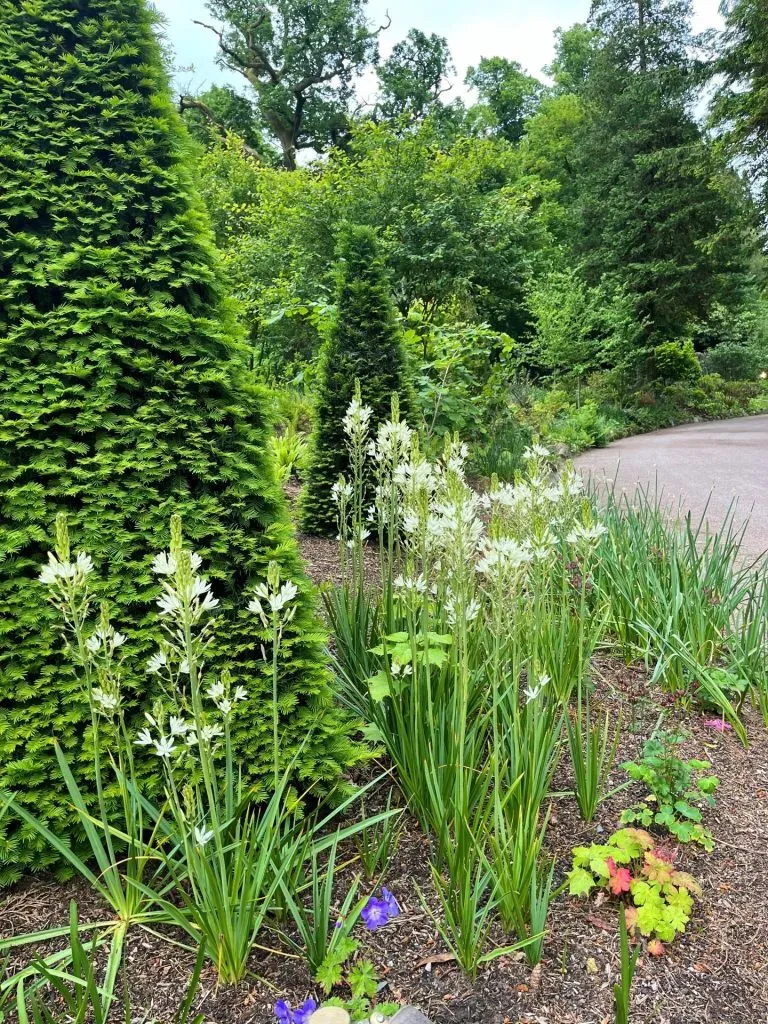

May has been a great time to admire the Rhododendrons in the garden. Here is one of our most spectacular specimens: Rhododendron ‘Yakushimanum Soft Pink’ Appearing like a fluffy pink cloud against the austere yew topiary.
– Alex
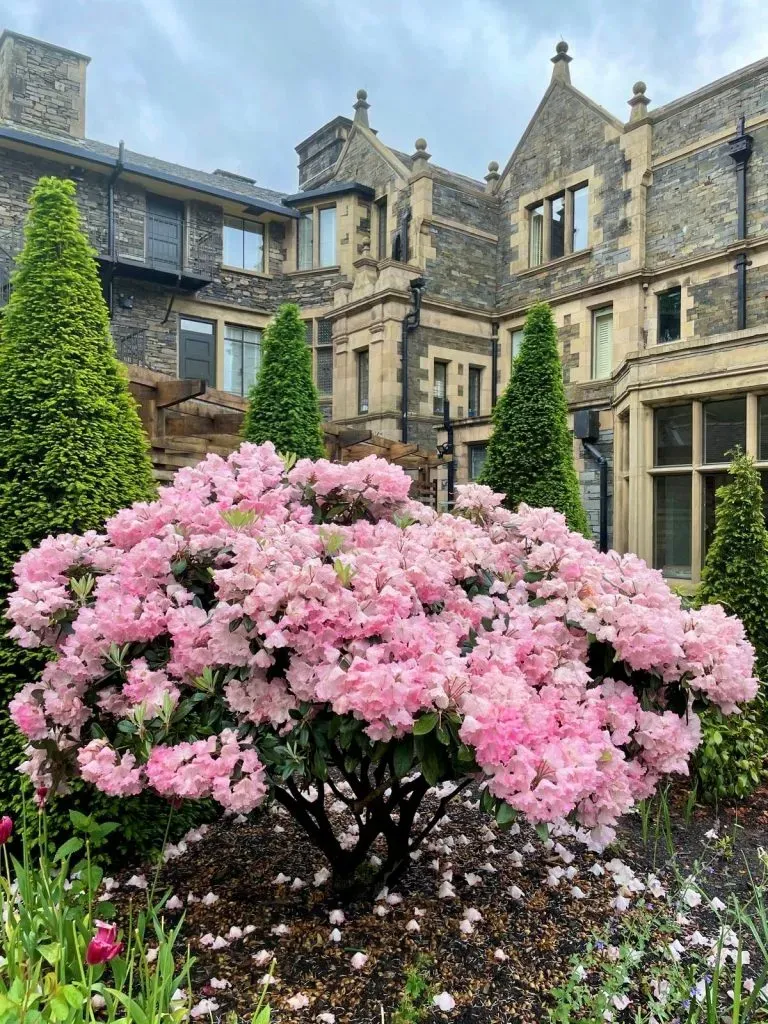

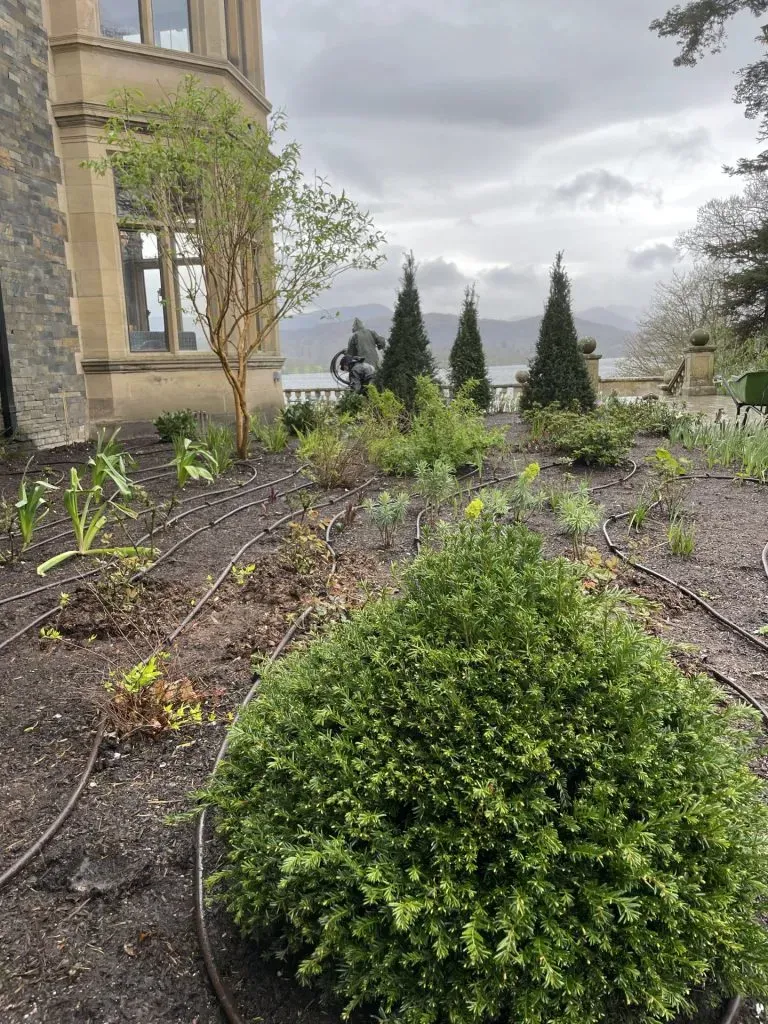
The first phase of our exciting garden redesign project included the planting of many large and mature specimens, such as the monumental Taxus baccata pyramids by the hotel entrance and the row of cherries – Prunus x subhirtella ‘Autumnalis Rosea’ in the drop off area. Mature specimens like these require a lot of watering throughout the growing season until their roots are well established; typically two to three years. One of the best attributes of the hotel is the terrace and the view – no other hotel can boast such a prominent Windermere lakeshore location! To care for our plants whilst minimising disturbance to our guests enjoying the terrace, we decided to install a leaky hose irrigation system. We have carefully (and painstakingly!) laid hundreds and hundreds of metres of leaky pipe, controlled by valve boxes which are, in turn, turned on/off by rain sensors. We’ve then buried these lengths of hose to make the whole system as discreet as possible. The irony is not lost on us in the garden team that for much of our irrigation install, we were working in the rain! It has been a steep learning curve for all of us but testament again to the resilience and hard work of the garden team to complete this project before the warm weather (hopefully) reaches us.
– Claire



On the sloping south facing border there are more varieties of Narcissi to enjoy; beautiful pure white ‘Thalia’ in layers, cascading down the slope interspersed with pops of cheery yellow from ‘Double Campernelle’. We’ve had an amazing display from all our Narcissus bulbs; they’re fully winter hardy, cope with our heavy clay soil and even all the rain the lake district has thrown their way hasn’t dampened their spirits.
– Claire


Similar in appearance to a snowdrop, only taller, this is Leucojum aestivum ‘Gravetye Giant’. It has several flowers on each stem and green tips to each of its petals. This bulb should happily self-seed and naturalise through the border given our incredibly moist conditions!
– Claire
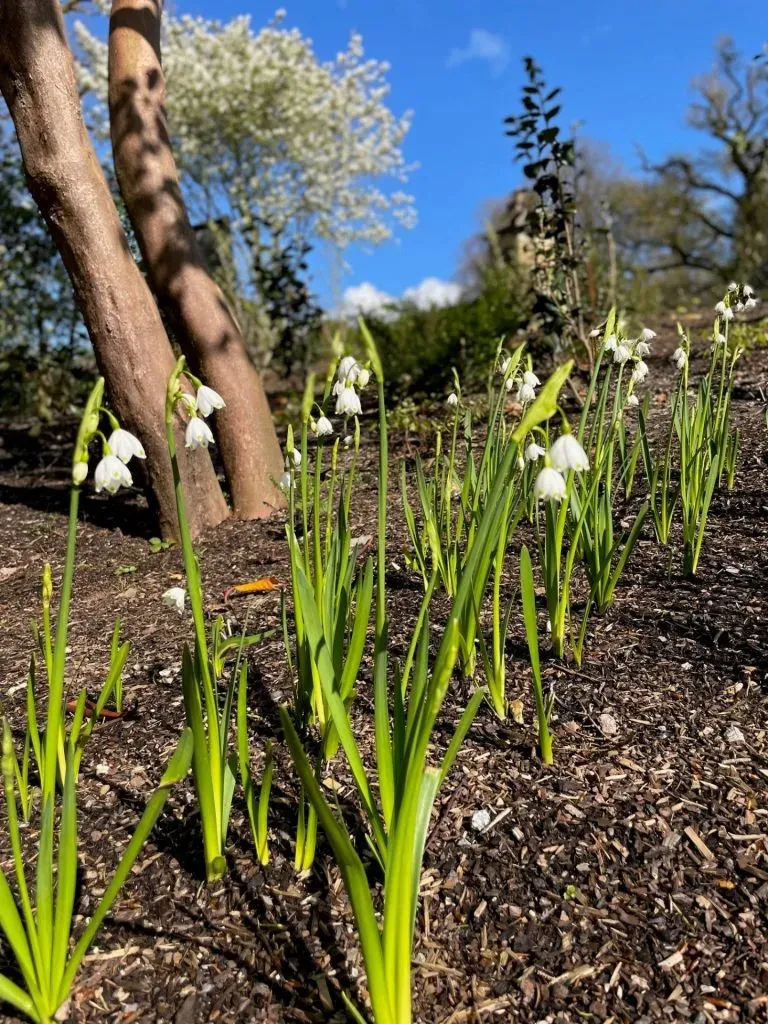

Many of our planted tulips suffered from the wet winter we experienced here on site and failed. Those that flourished look superb in the borders; the sunshine catching Tulip ‘Salmon Prince’ highlights the paper like delicacy of the petals and the blend of colour to give the overall salmon appearance. Over successive years in the ground tulip bulbs divide into smaller bulbs which are not large enough to provide a flower, or they may rot or develop tulip fire. In the summer months we will dig them up, dry them out and store them ready for replanting to give them the best chance of display next season.
– Claire


Along the roadside woodland border we planted 4 different varieties of narcissi bulbs; 4000 in total. The different varieties will flower at slightly different times and here we can see Narcissus ‘Actaea’ in a large, impactful drift complemented by the upright deep violet flower spikes of Muscari latifolium. All our bulb varieties were expertly selected by garden designer Annie Guilfoyle and placed and planted by the garden team.
– Claire
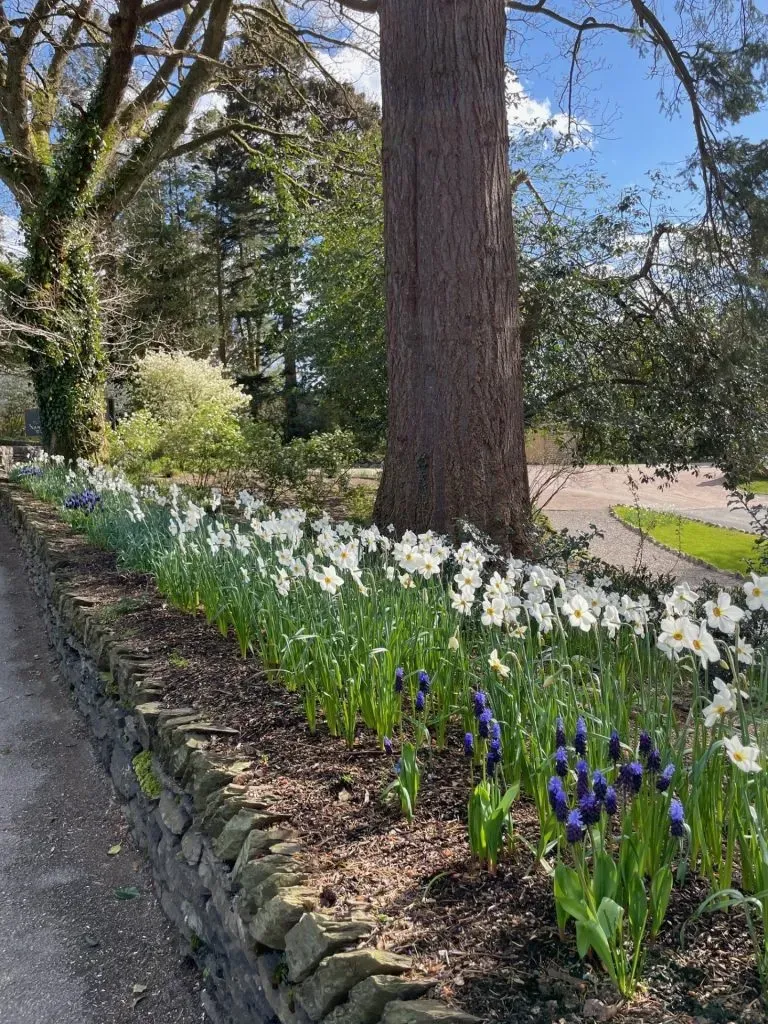

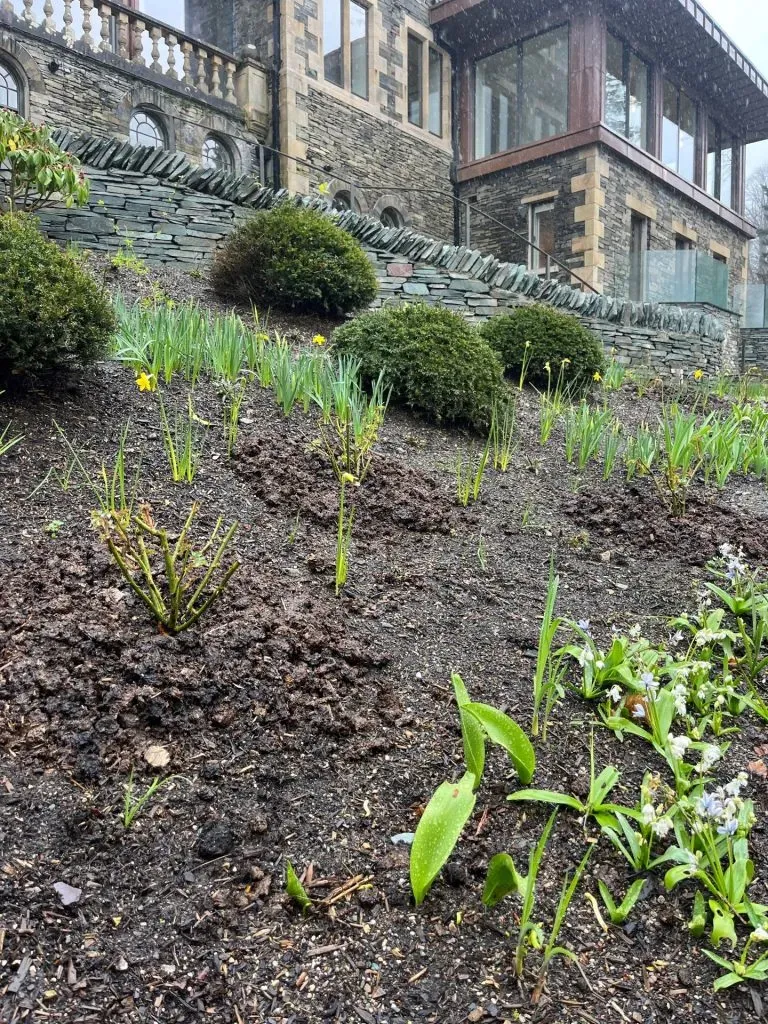
As the buds begin to swell on our roses and climbers, we have the luxury of being able to apply a generous mulch of Thwaites’ own produced manure. Supplied by the brewery’s own Shire horses, and fed on a diet of hay and spent barley.
We have fed around 80 roses and climbers, giving the new plants a great start for their first spring in the garden.
– Alex



As the buds begin to swell on our roses and climbers, we have the luxury of being able to apply a generous mulch of Thwaites’ own produced manure. Supplied by the brewery’s own Shire horses, and fed on a diet of hay and spent barley.
We have fed around 80 roses and climbers, giving the new plants a great start for their first spring in the garden.
– Alex


The South Slope has slowly burst into colour over March, and the species Tulips have begun to appear. This is Tulipa humilis ‘Persian Pearl’.
– Alex
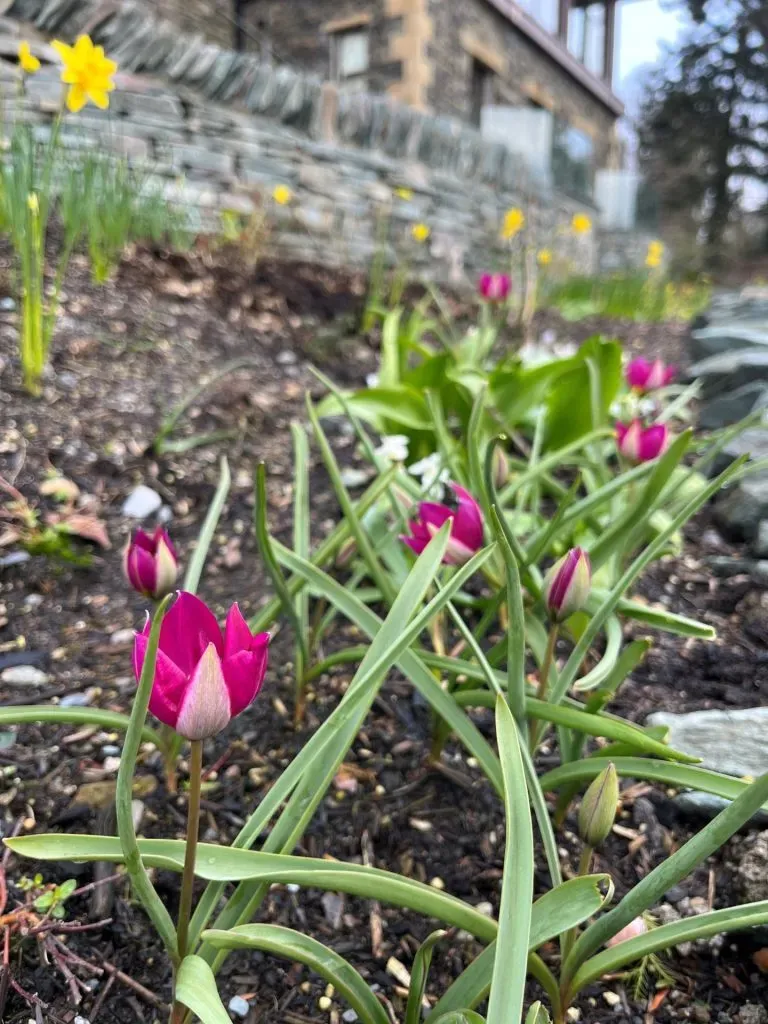

As we begin April and the temperatures begin to lift (hopefully), we are able to begin adding the pot grown Eremurus ‘Pinokkio’ to the planting on the South Slope.
Eremurus dislikes the wet winters we have here in the UK and even more so in the Lake District. Therefore growing them is somewhat challenging. However, we are able to achieve this by planting their Octopi like bulbs in a free draining soil mix in the greenhouse. Once the temperatures rise, we plant them outside on a mound of grit and pray for no late frosts (Cloches at the ready just in case).
– Alex


There’s nothing like the acid greens of Euphorbia characias ‘Wulfenii’ to wake you up on a grey morning. This is a strong reliable grower, even after its first harsh cumbrian winter here at Langdale Chase. It’s easy to forget that this is a classic Mediterranean plant.
– Alex
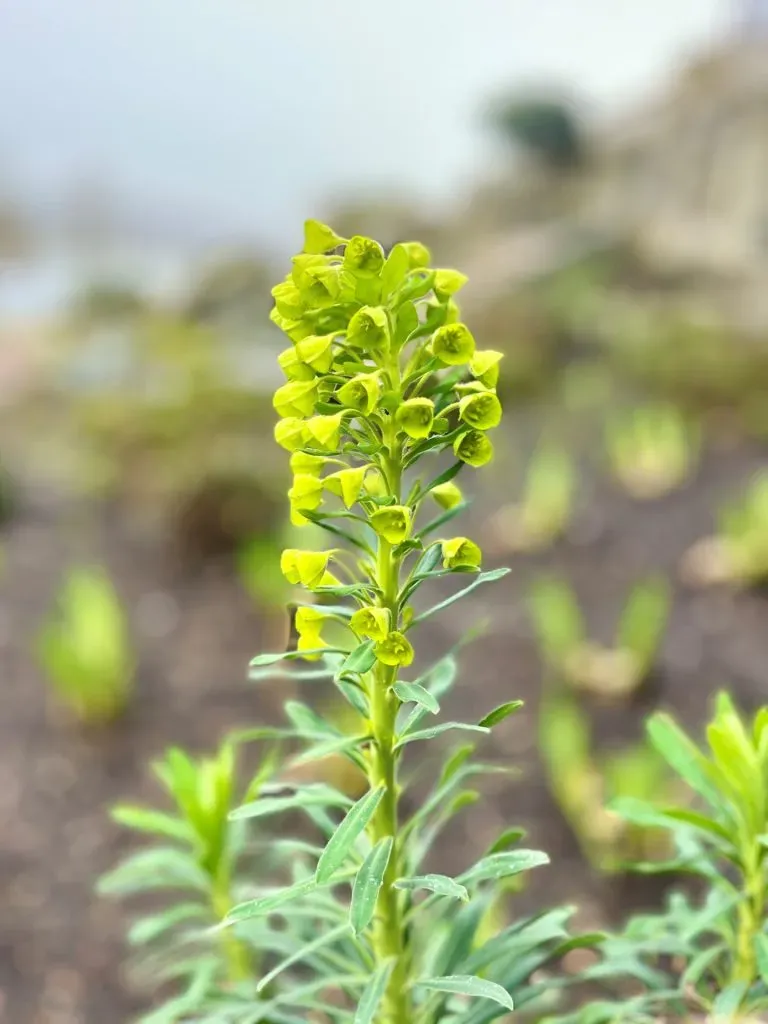

Taking pride of place near the terrace is our Cornus mas, revealing airy flowers on its naked stems. At this pivotal time for the garden we can now enjoy seeing the first buds and flowers on some of our newly planted specimen shrubs and trees.
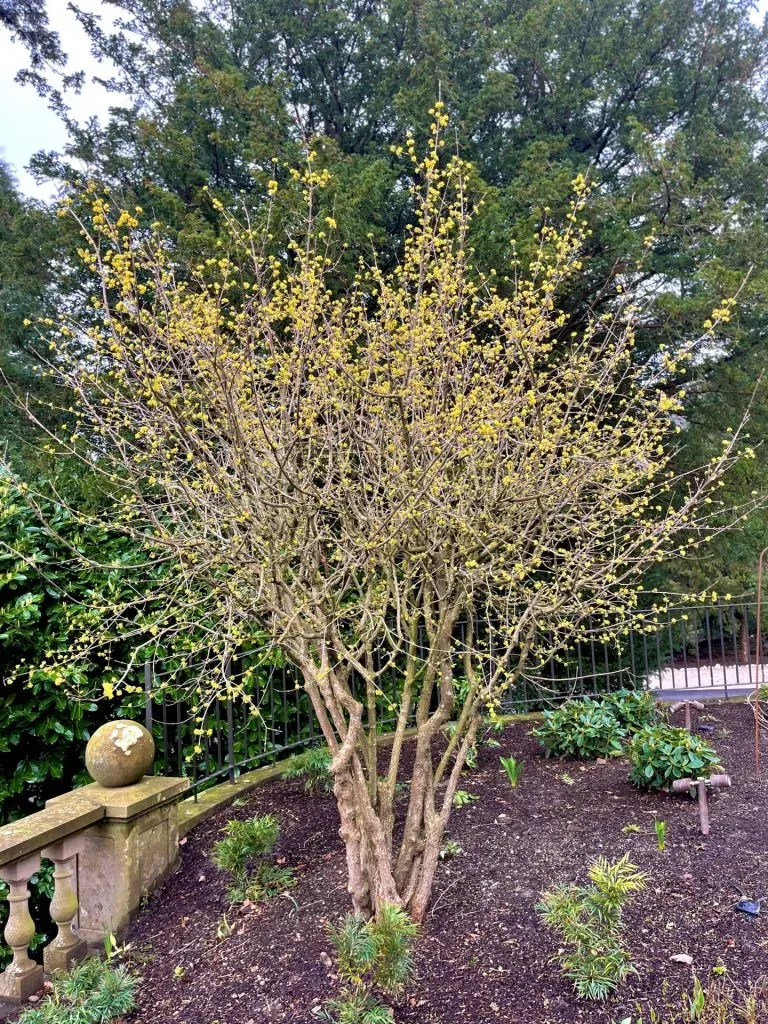

As you arrive at the entrance you will be greeted by the ruffled blooms of the Camellia japonica ‘Lulu Belle’.
– Alex


As we ebb slowly towards Spring, our winter of toiling in the cold and rain is being rewarded. At this time of year the garden is revealing some of the most delicate and minute displays. Here is the Puschkinia libanotica, commonly referred to as the Russian snowdrop, catching some winter sun on the south slope. This is the earliest bulb to flower in the garden.
– Alex
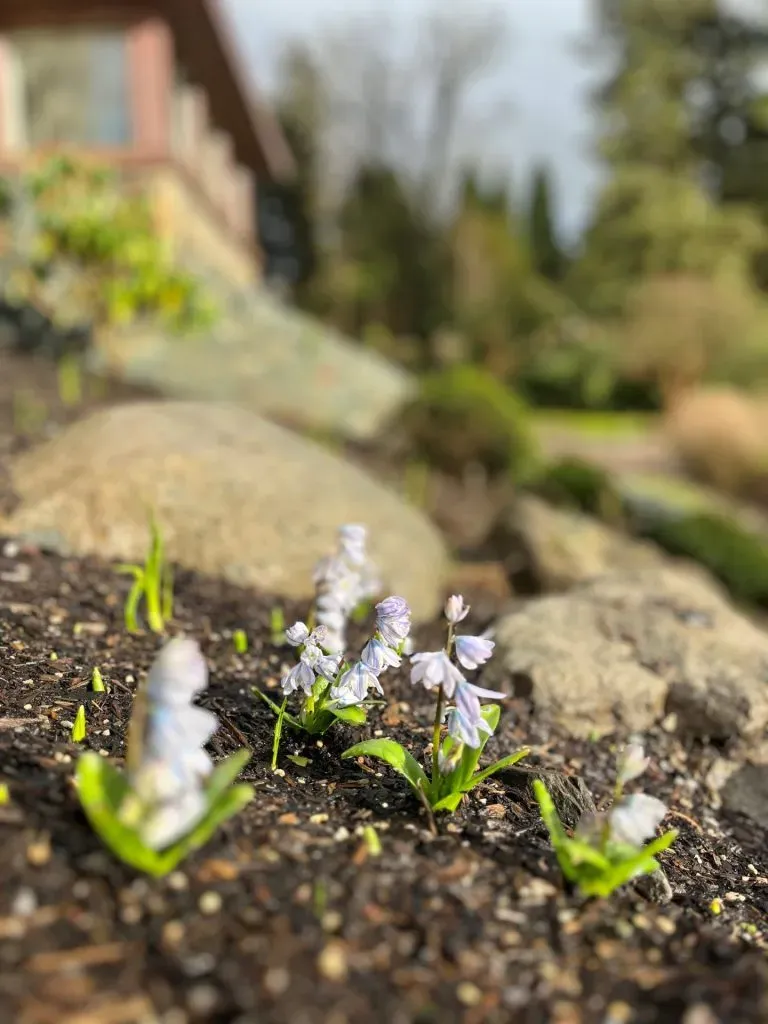

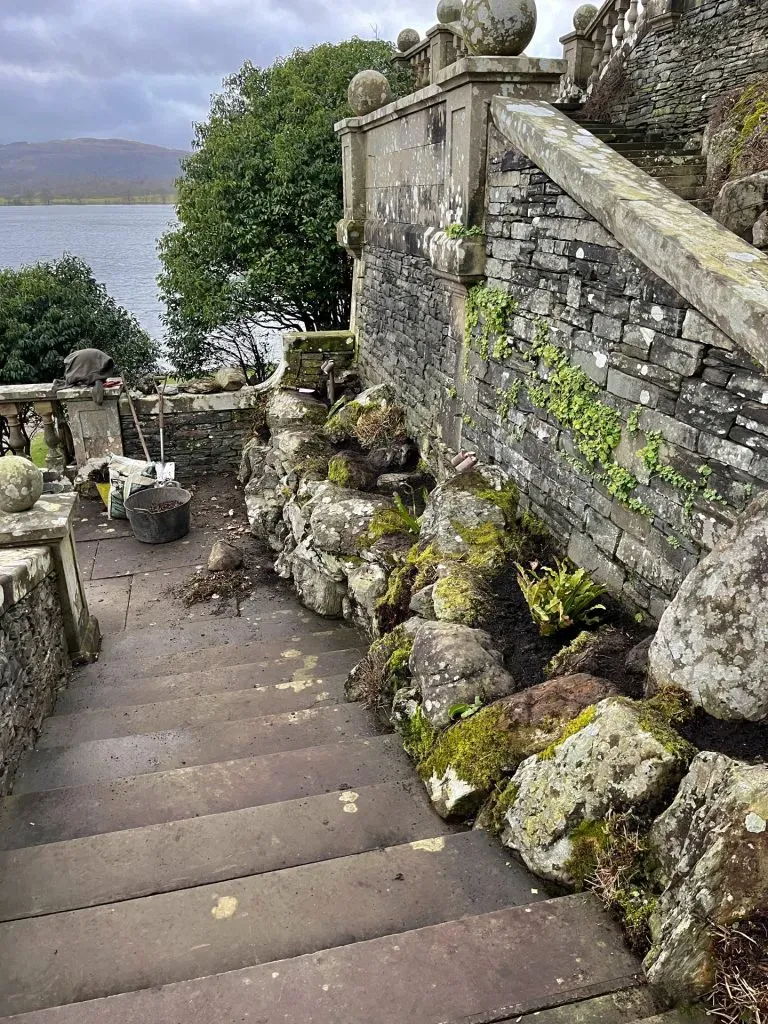
The addition of the beautiful copper lights left us with some unpleasant electrical cabling in the original Mawson rockery. Charlotte and Alex did a fantastic job moving in stones and positioning them to look as if they’ve always been there, masking these cables. The lower sections were completely overwhelmed by ferns too, which offered an additional challenge. Most were removed but some were re-positioned to poke out from behind rocks, and the smaller, more delicate plants moved into the new planting pockets created. We have grand plans for this area – watch this space!
– Claire
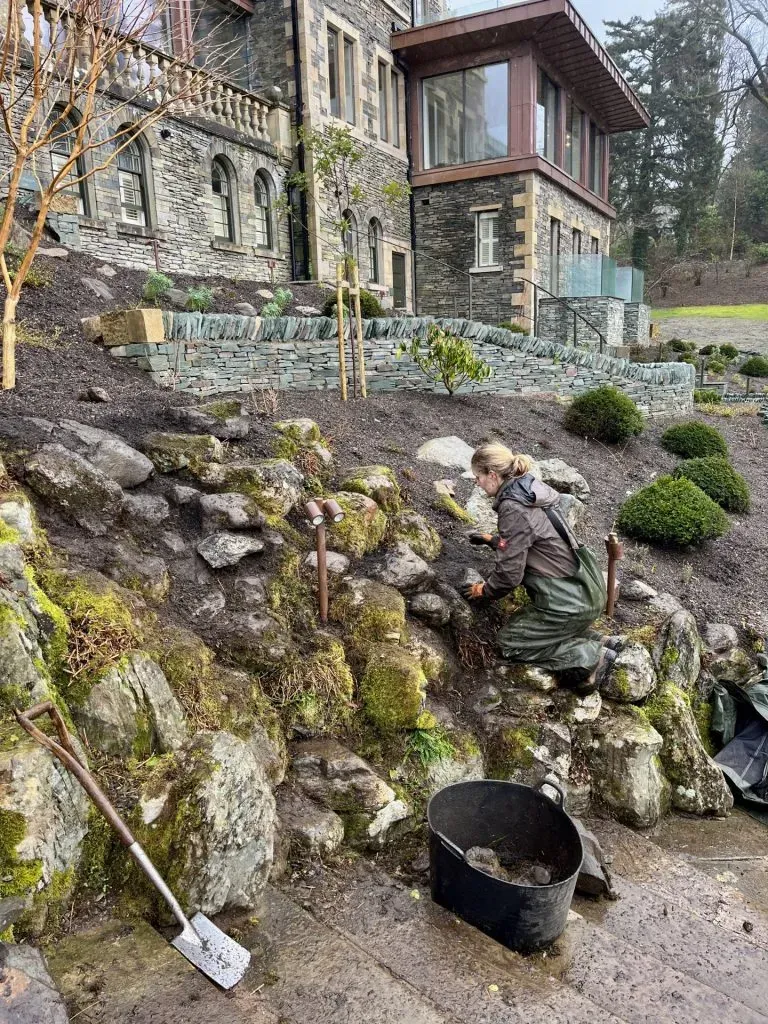


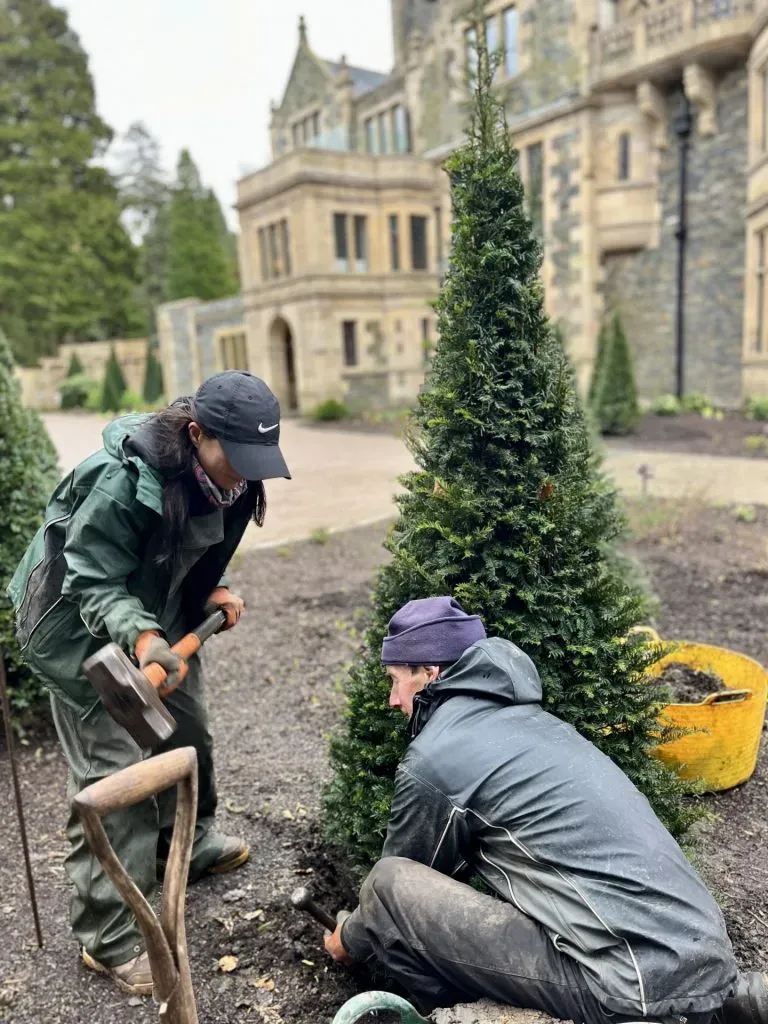
Our yew (Taxus baccata) topiary pyramids have been bearing the brunt of the season’s gale force winds and it was clear they needed some additional support. Here Trevor and I are, taking turns hammering in the platypus anchoring system. This is a discreet, underground system for stabilising our mature root ball specimens, removing the need for any unsightly overground staking – let the focus be the beautiful planting!
– Claire
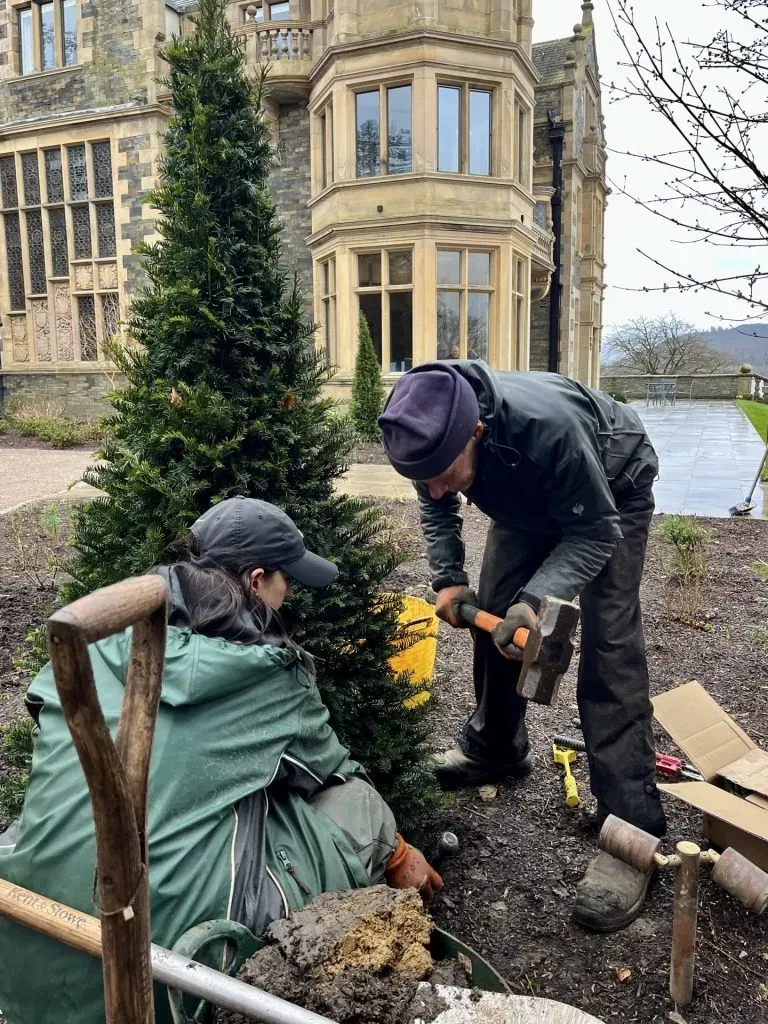


February is here and the Edgeworthia chrysantha has finally decided to grace us with its beautiful, elaborate flowers. Over this month we will see these unfurl further and reveal a half globe of star shaped flowers.
– Alex


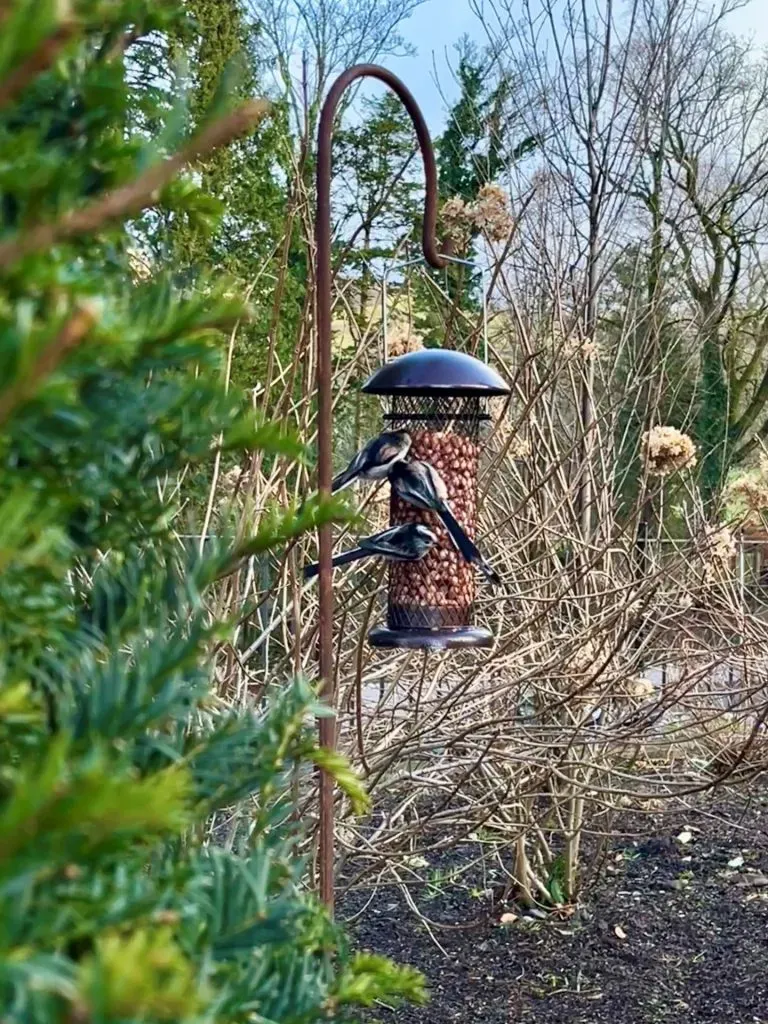
In an effort to help and encourage wildlife within the garden, we have installed a number of bird feeders in two sheltered locations. Here you can see 4 Long Tailed Tits on one feeder (spot the fourth bird’s tail poking out from behind the feeder).
This initiative has been spearheaded by fellow gardener Trevor, who has a background in wildlife conservation, and a wealth of knowledge for all things avian (Spot Trevor in the second photo).
We have also taken part in the RSPB’s 45th Big Garden Birdwatch and recorded the results of an hour of birdwatching…
9 Blue Tit
5 Great Tit
3 Coal Tit
2 Chaff Finch
1 Green Finch
2 Gold Finch
2 Bull Finch
1 Nut Hatcher
2 Robin
1 Dunnock
1 Great Speckled Woodpecker
3 Black birds
2 Crow
1 Goldcrest
– Alex



As we battle the elements in this exposed garden, we find many challenges, and plenty of damage.
Here we have Camellia ‘Mars’, its new flowers emerging. However some have succumbed to frost damage, leaving them misshapen and brown. Another example of the extreme weather this garden faces.
– Alex
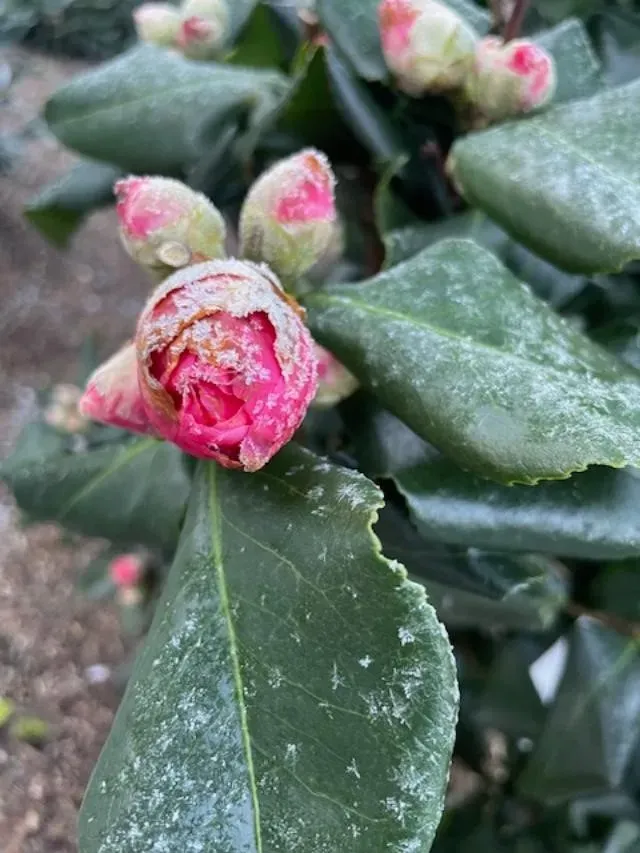

Whilst clearing out the Bothy, we managed to find a great bit of history from the gardens heyday – a plaque in commemoration of a record high for lake Windermere.
This dates back to around the time that the Thomas Mawson designs were being laid out.
Now we just need to do a bit of research and find out where it was originally placed (Keep an eye out for it on future visits to the garden).
– Alex


The snow and ice of January put a stop to our regular gardening duties. However this gave us an opportunity to take refuge in the “bothy”, which has been in desperate need of a renovation.
With years worth of spiders webs removed, and wooden frames built to hang all our tools (very satisfying) – we now have a garden shed to be proud of.
– Alex
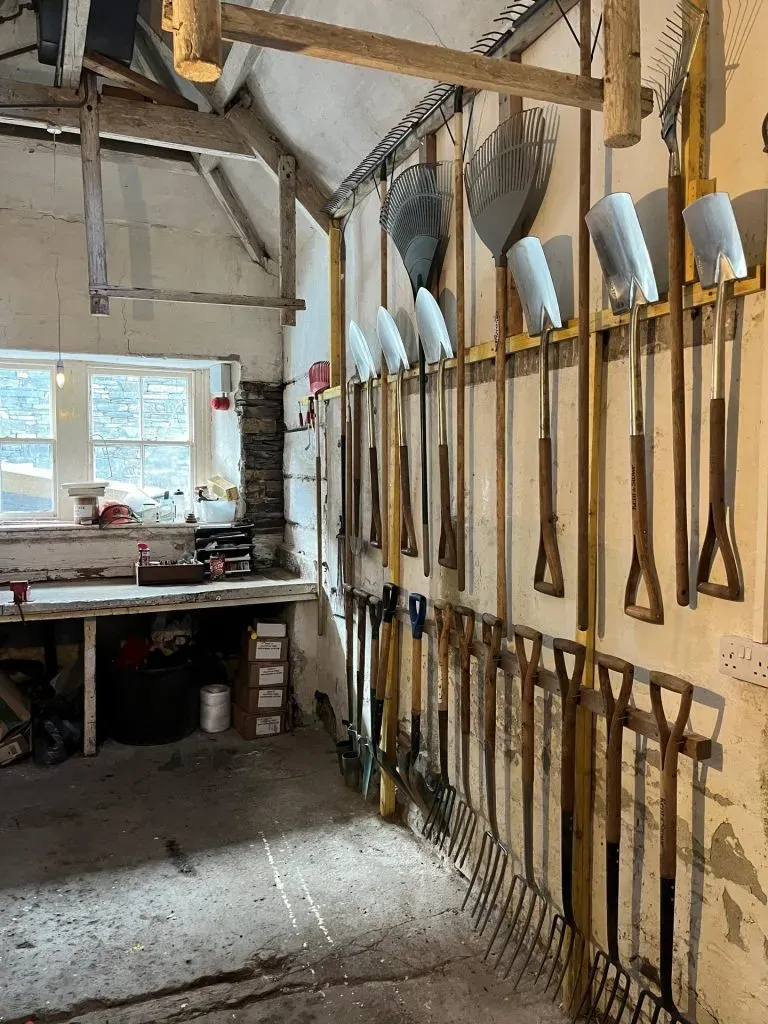

As the freezing temperatures blanketed the garden in snow and ice, something caught our eye – In a shady area of the garden a solitary flower of the Camelia japonica ‘Mars’ stood out. As the month rolls on we should see the gradual unfurling flowers of of numerous Camellias, bringing a burst of colour to the entrance and roadside of the garden.
– Alex
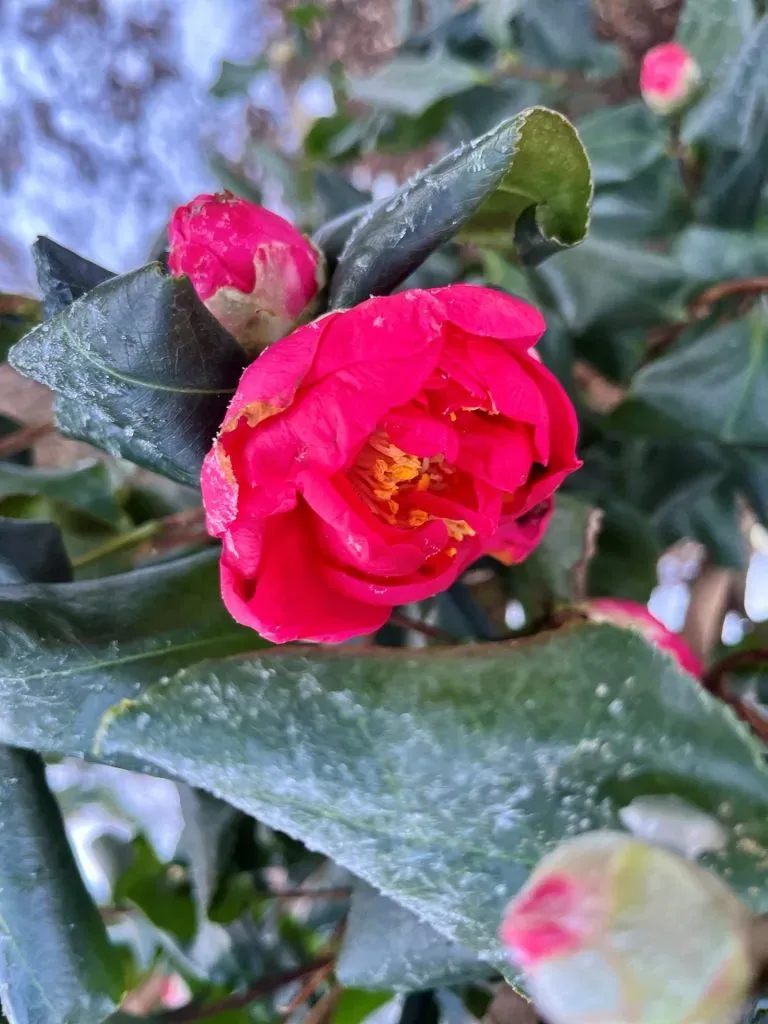

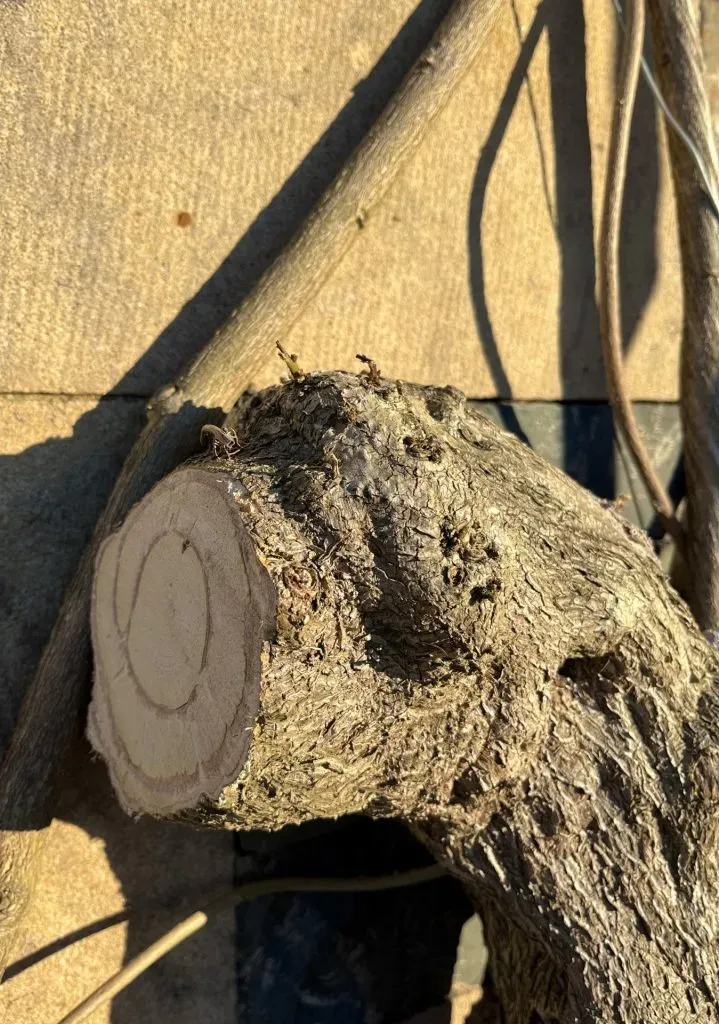
On a sunny winter day – we can be found with our Tripod ladders, doing some structural pruning. In this case, the mature Wisteria Chinensis which adorns the terrace. It had seen better days, and was in need of a renovation – so we have removed any unproductive old stems, and cut back any unwanted long whips. All the time observing its overall shape.
It is a long process to bring it back to a nice framework, and create a more floriferous specimen. Luckily we can see new buds breaking on the older wood (Yay).
– Alex



The first of our Camellia flowers has finally opened. This variety is Camellia ‘Lulu Belle’ and has delicate, soft petals. You can find it welcoming guests on their arrival by the hotel entrance sign.
– Alex
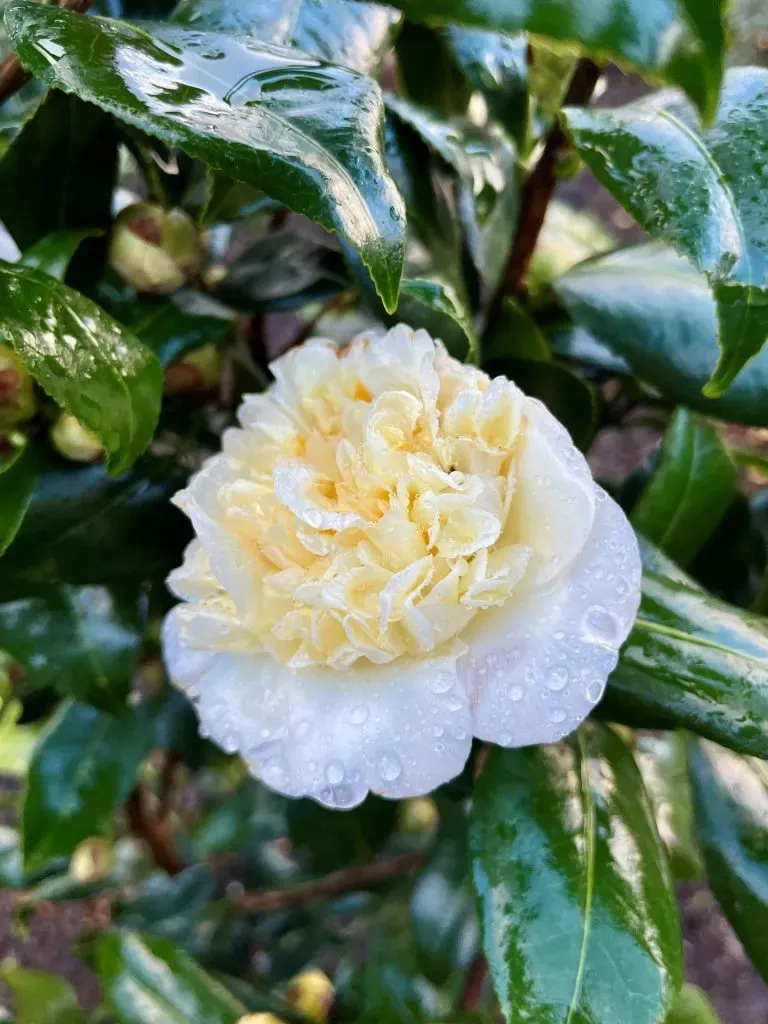

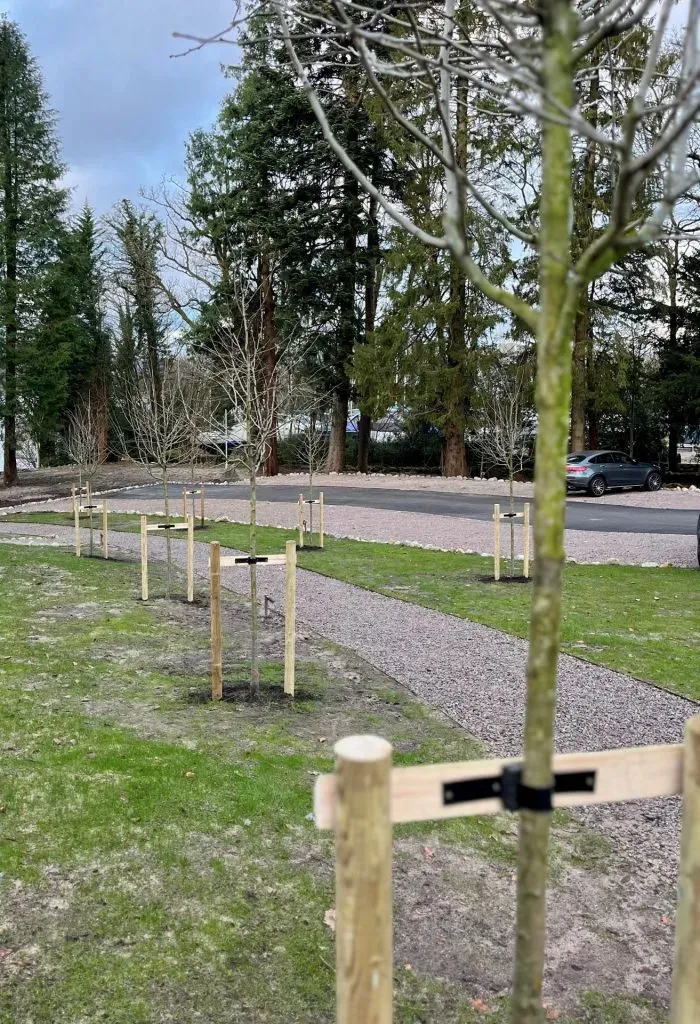
A crucial job for the longevity of our newly planted trees is supporting their growth in our exposed and windswept site. Here we are double staking our 12 Hawthorn trees (Crataegus laevigata ‘Paul’s Scarlet’), which line a walkway from the parking area to the hotel entrance. We can’t wait to see its double pink flowers blooming in May.
– Alex
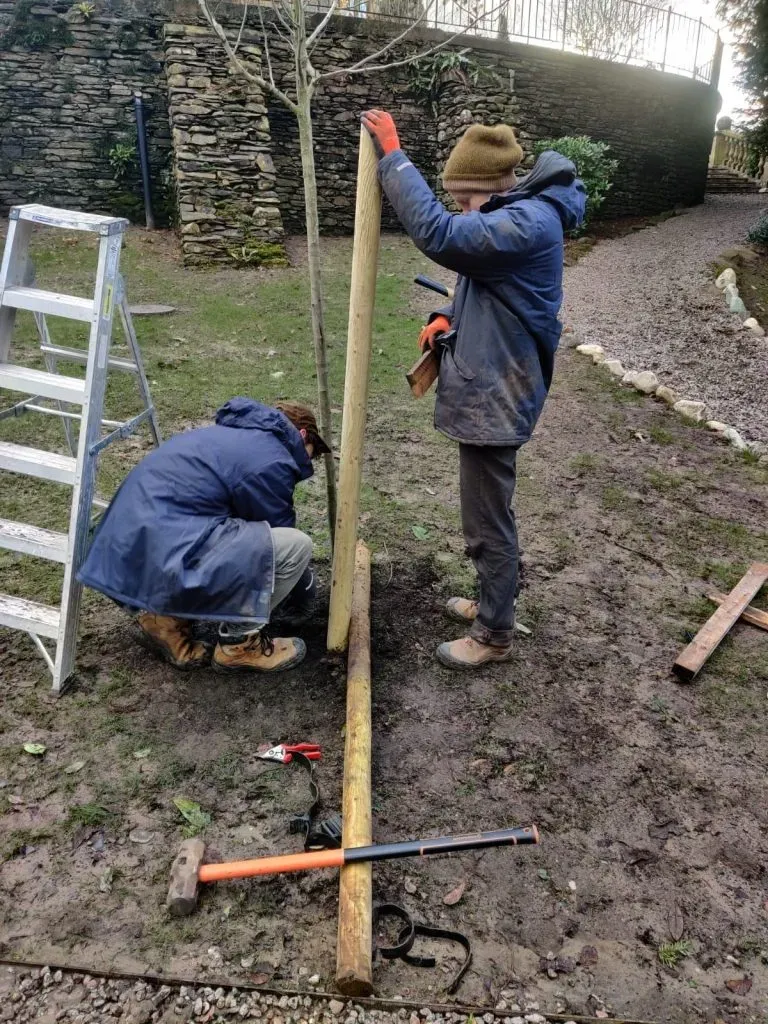


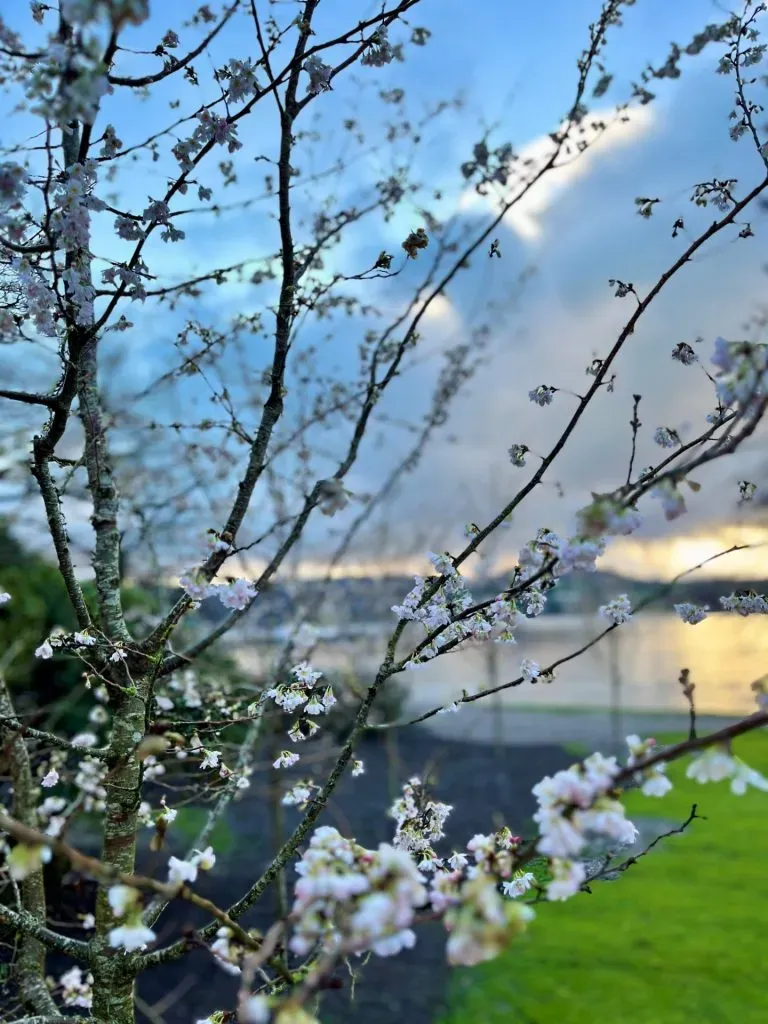
Abi & Tom’s Garden Plants – www.abiandtom.co.uk
Our dreary winter days have been punctuated by the uplifting blooms of the Cherry trees (Prunus x subhirtella ‘Autumnalis’) – such great specimens to bring cheer and hope of the spring to come. It really has been a joy for us to see these buds opening.
– Alex
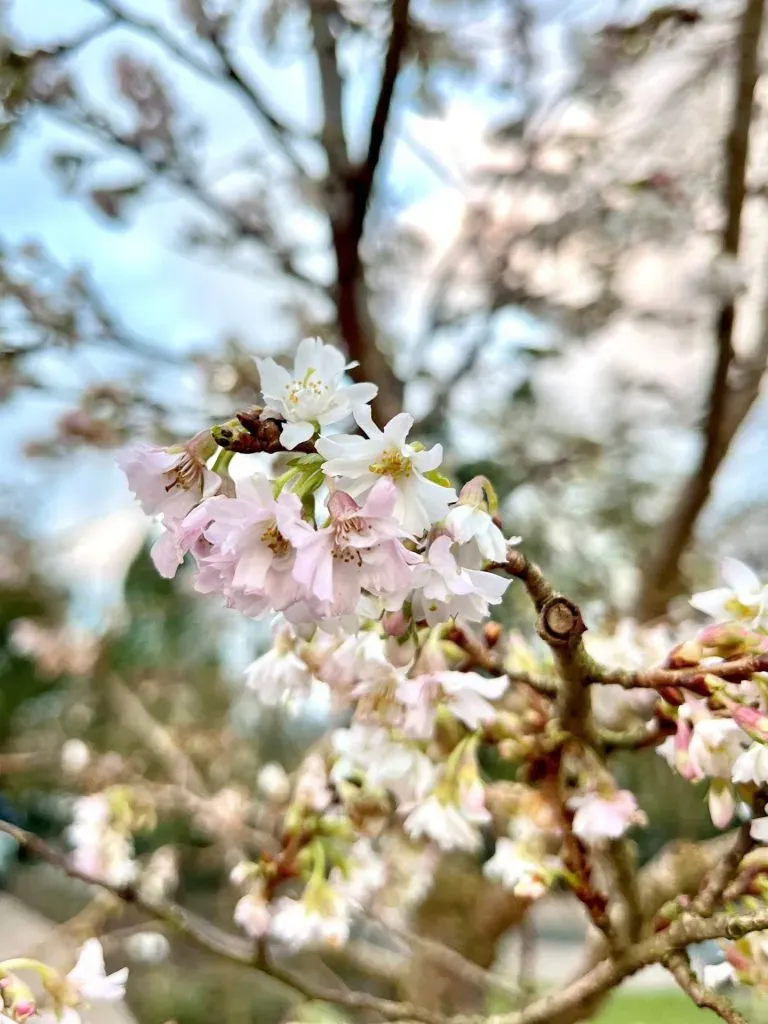


Over the last few months here in the garden we have been busy planting 30,000 bulbs; a long process, but with great reward come spring. Here you can see our placement of Tulip bulbs through the formal Yew (Taxus baccata) topiary to create an eye catching burst of peaches and oranges with a contrasting burgundy colour. They will flower alongside a succession of spring bulbs: Crocus, Narcissus and Alliums to name but a few.
– Alex
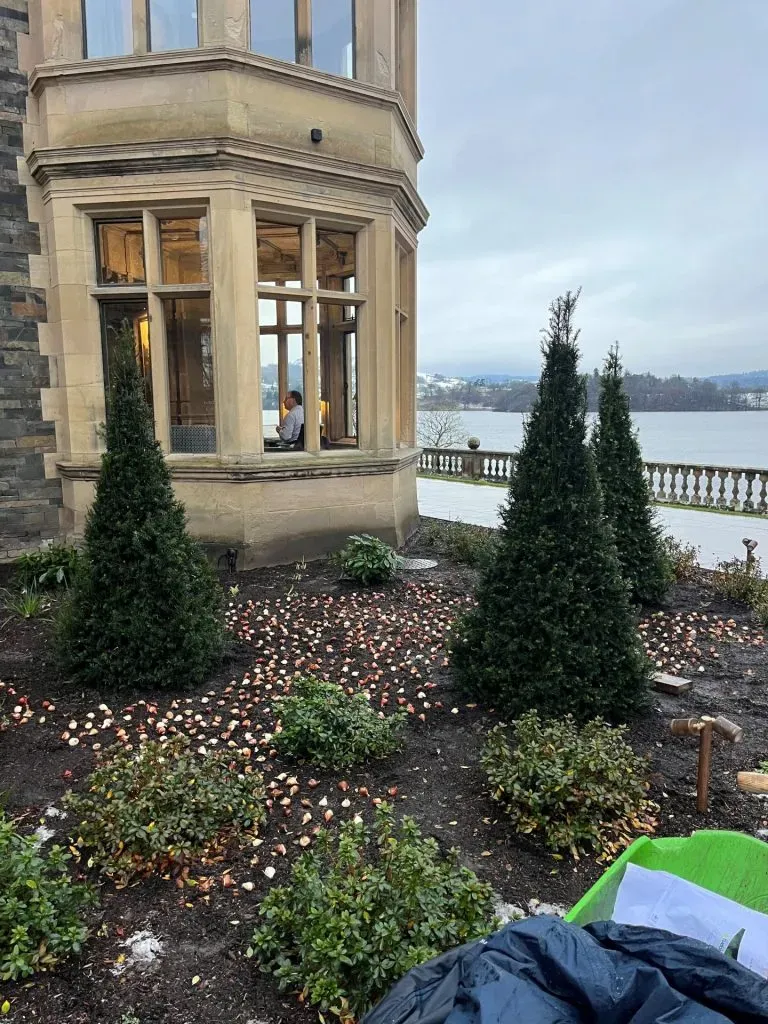

One of the most dramatic features of the garden is the South Slope – steep and rocky, much like the surrounding landscape. Here we are planting a cascade of trees, shrubs and sun loving perennials. It’s tough terrain for gardening, but not so bad when you’re rewarded with these views.
– Alex
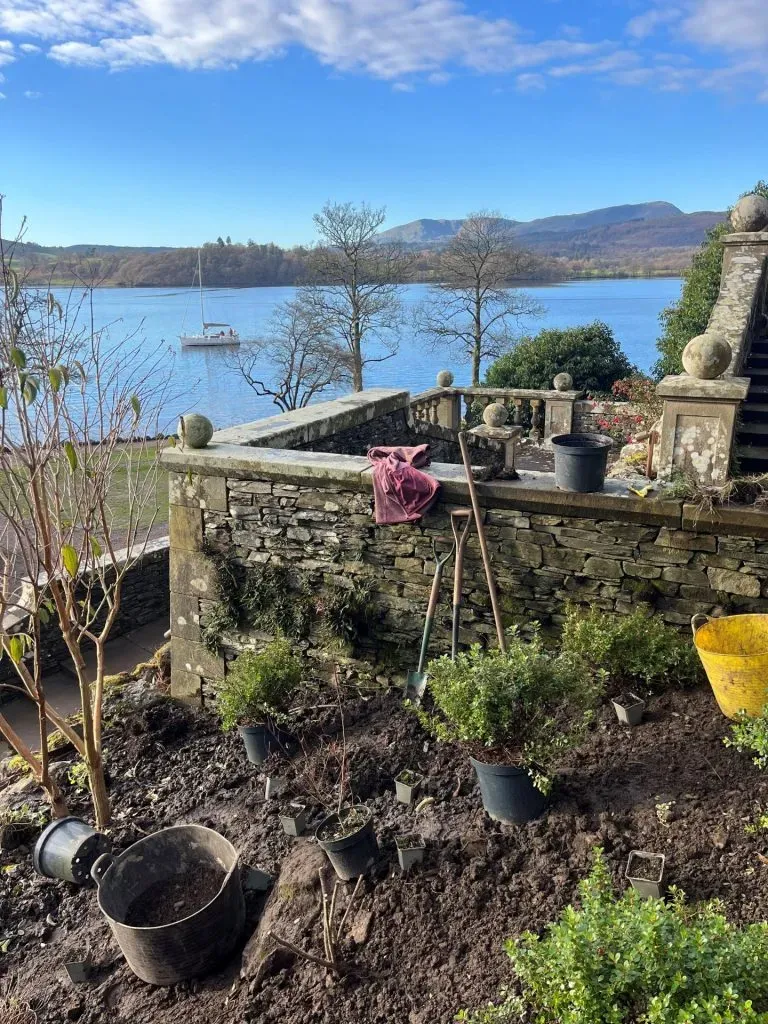

The newly completed entrance borders looking crisp. The Yew (Taxus baccata) pyramids tower above more delicate perennial planting and provide a statuesque, formal backbone to the garden over the winter months.
We can’t wait to see the brilliantly crafted pergola covered in climbers later in the year.
– Alex


We caught up with our Head Gardener, Claire Farrington to find out what inspires her and what made her come to Langdale Chase.

Indulge in the ultimate luxury at Langdale Chase, a stunning hotel renowned for its exceptional service, picturesque location, and elegant ambiance. Experience the warmth of our hospitality, savor exquisite cuisine, and explore the breathtaking beauty of the Lake District.
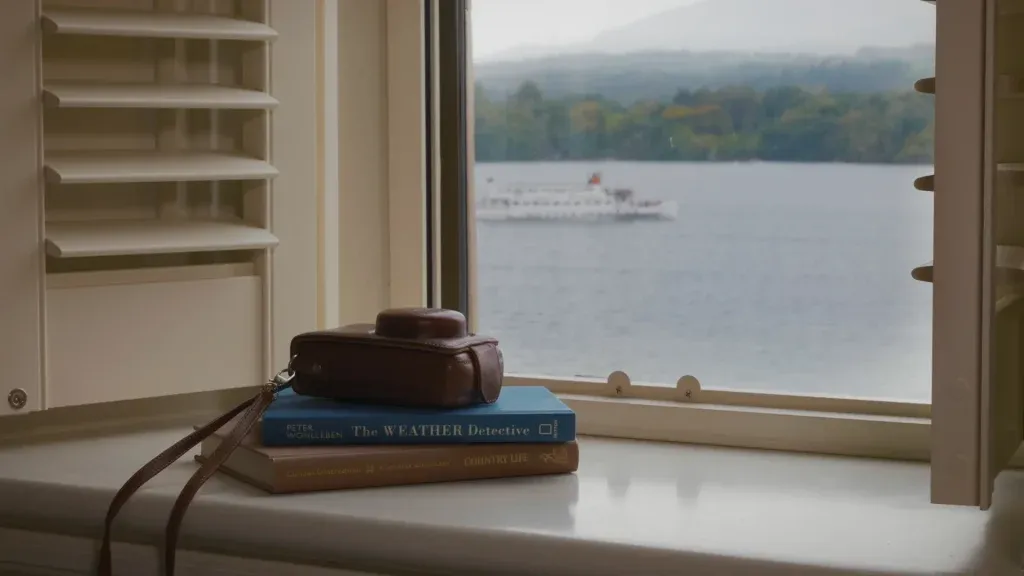
Langdale Chase has officially reopened after a year of restoration. To celebrate, a reception was held with Rick Bailey, Executive Chairman of Daniel Thwaites, and Samantha Scott, High Sheriff of Cumbria.
